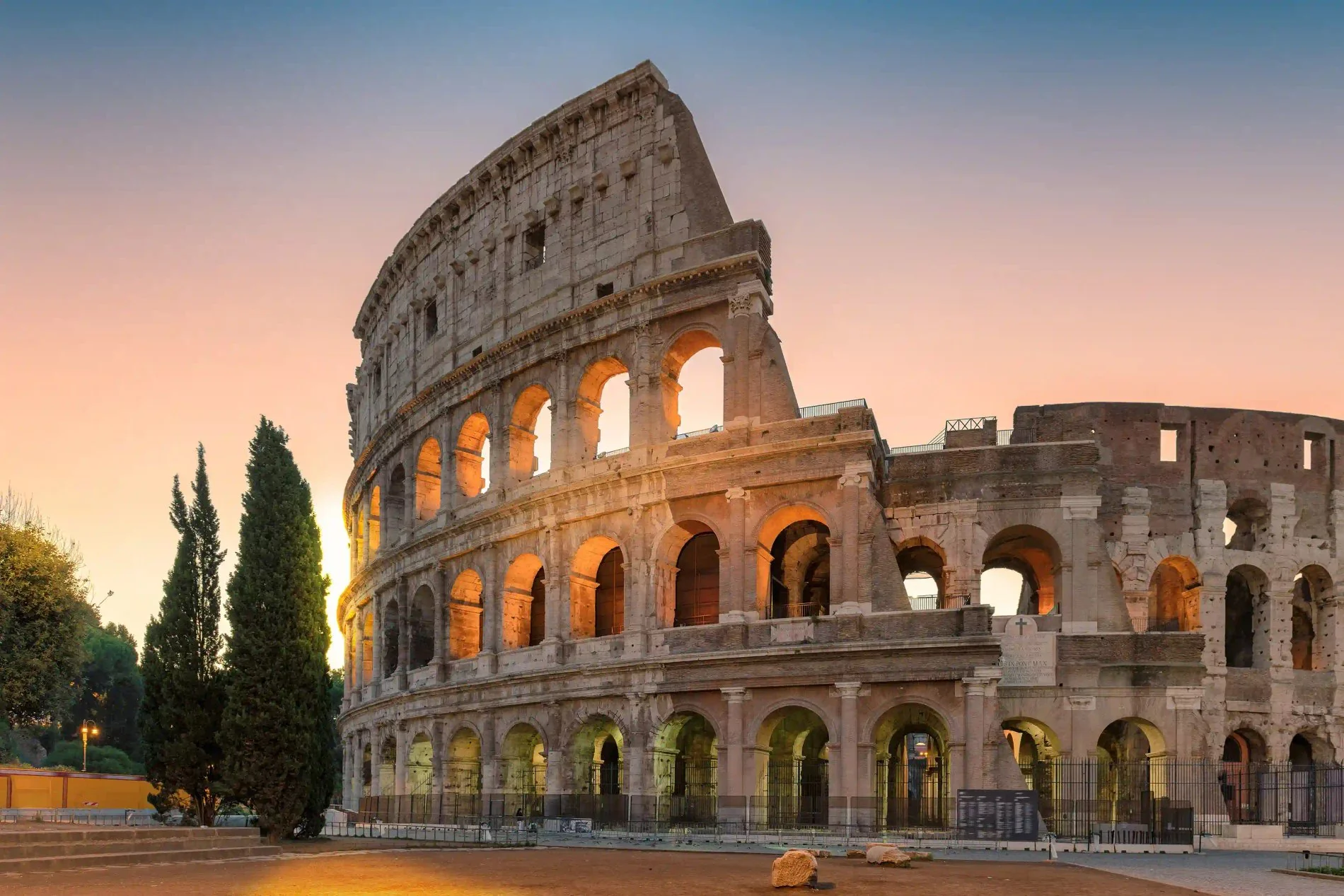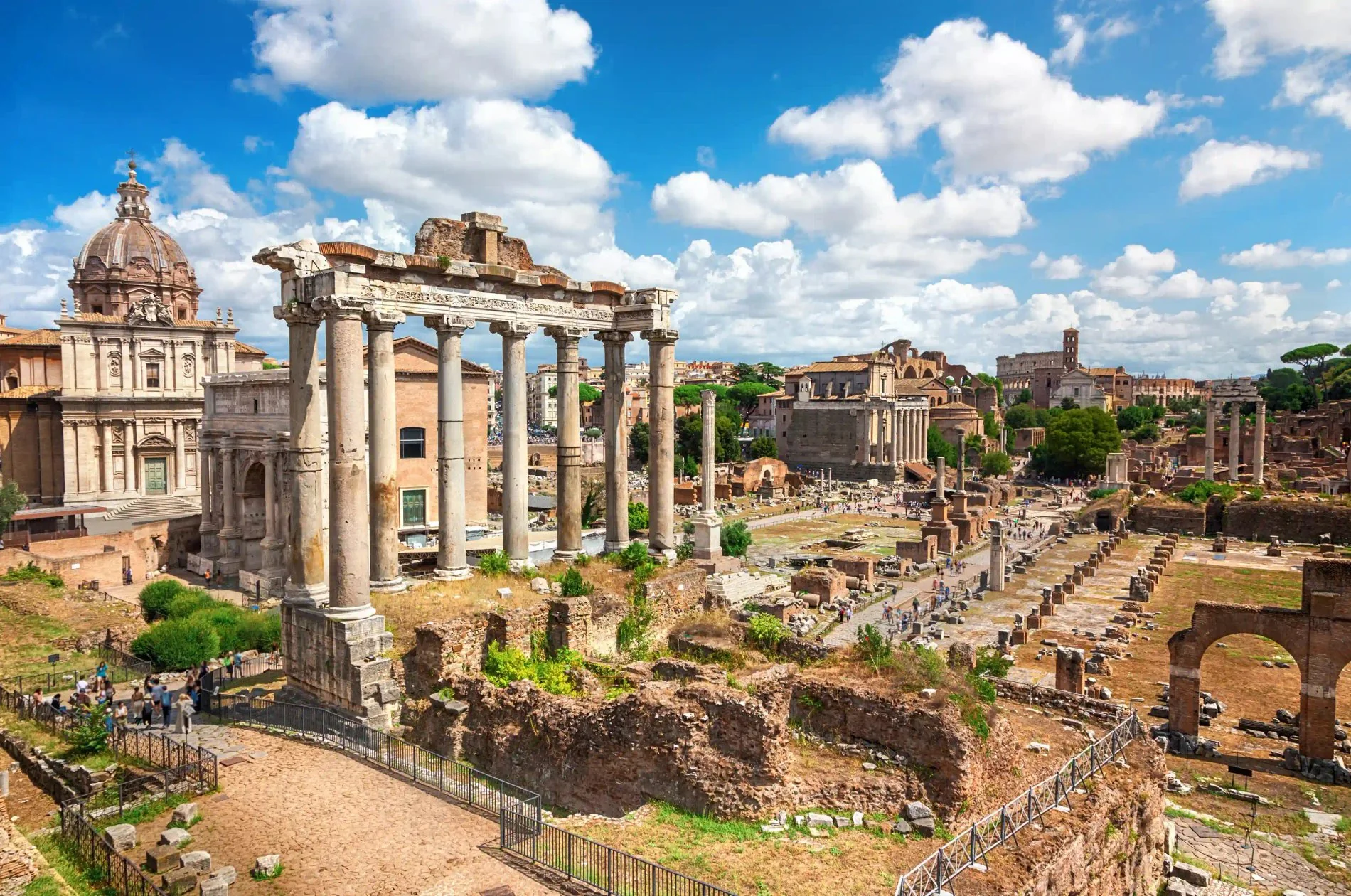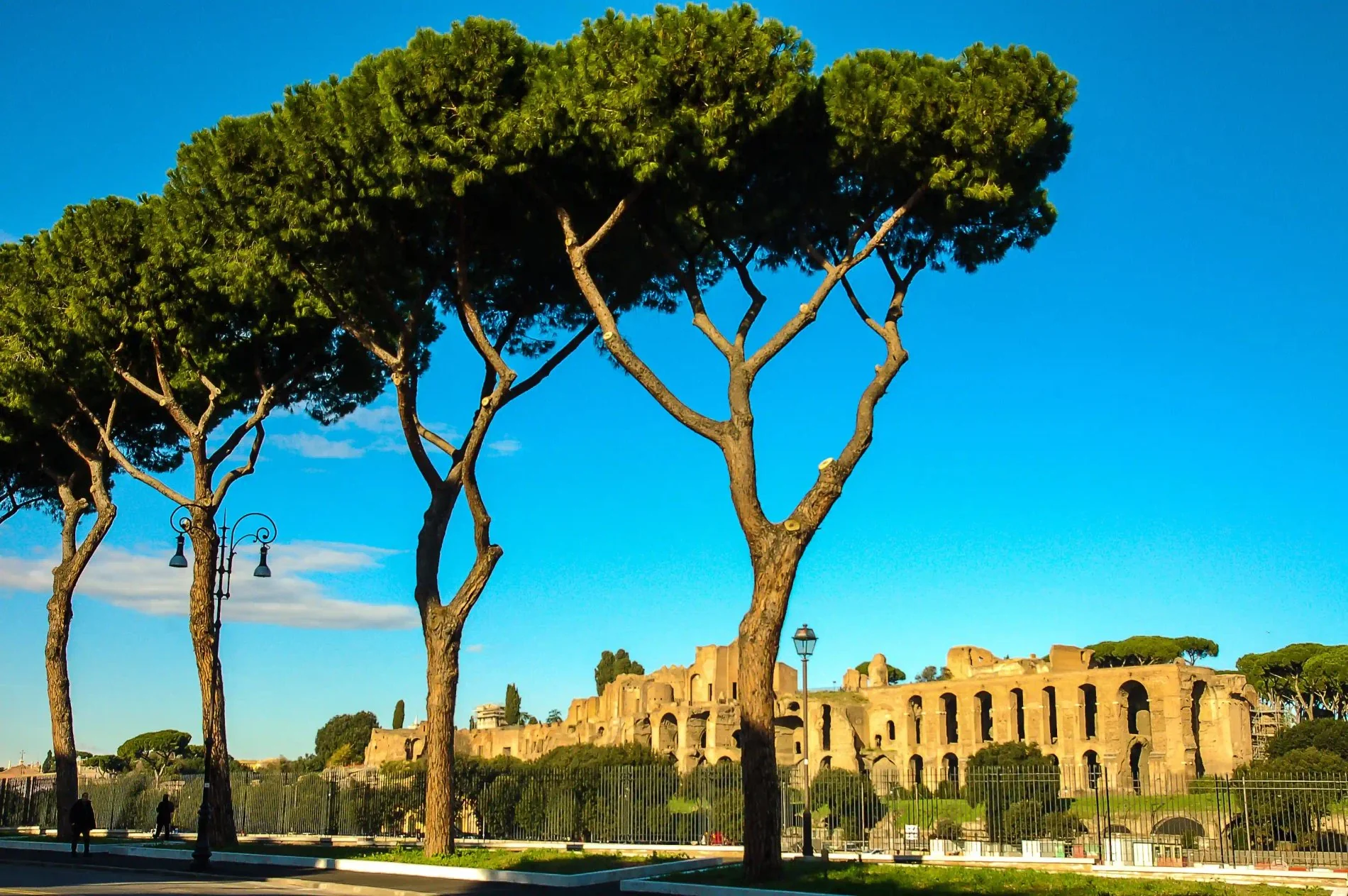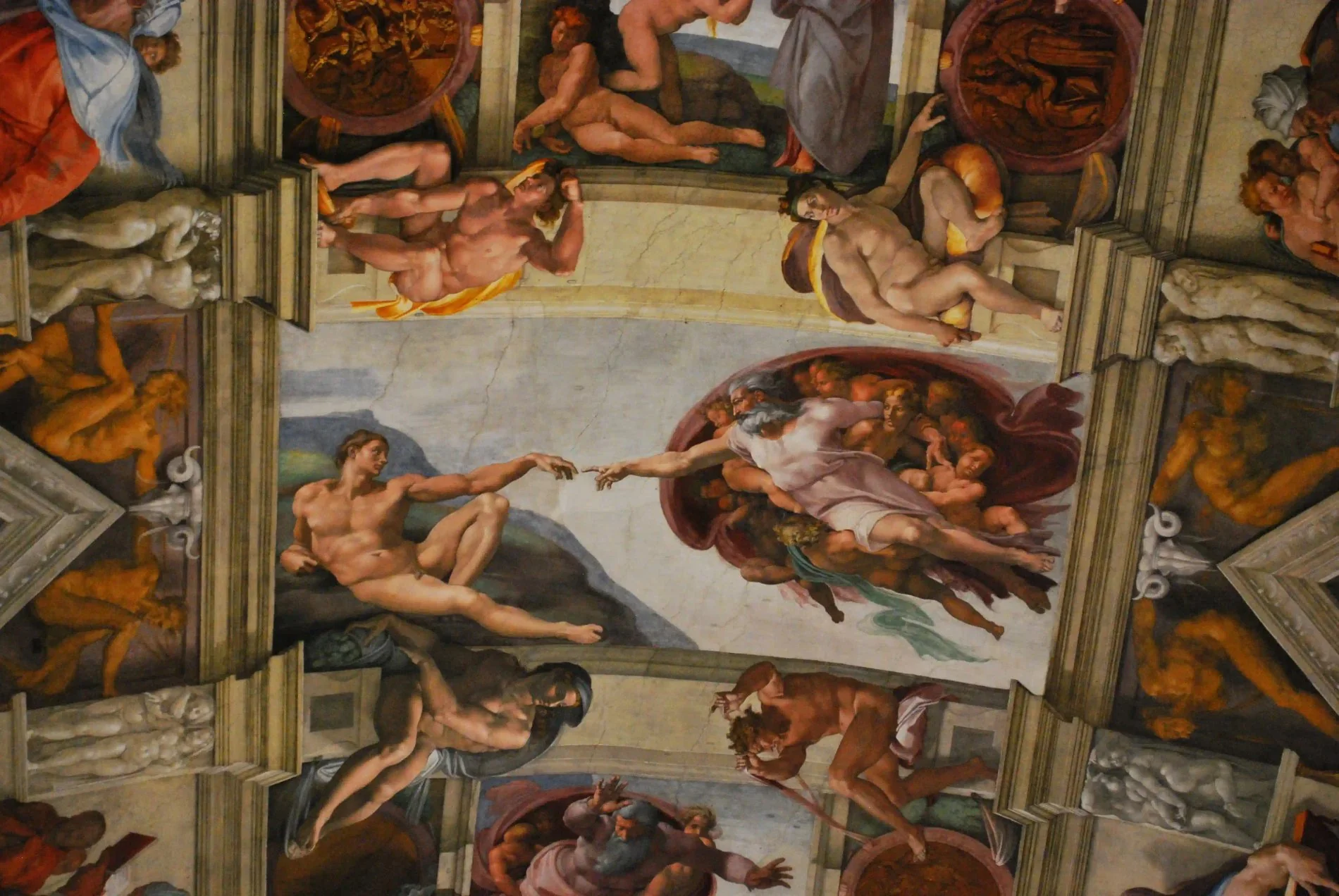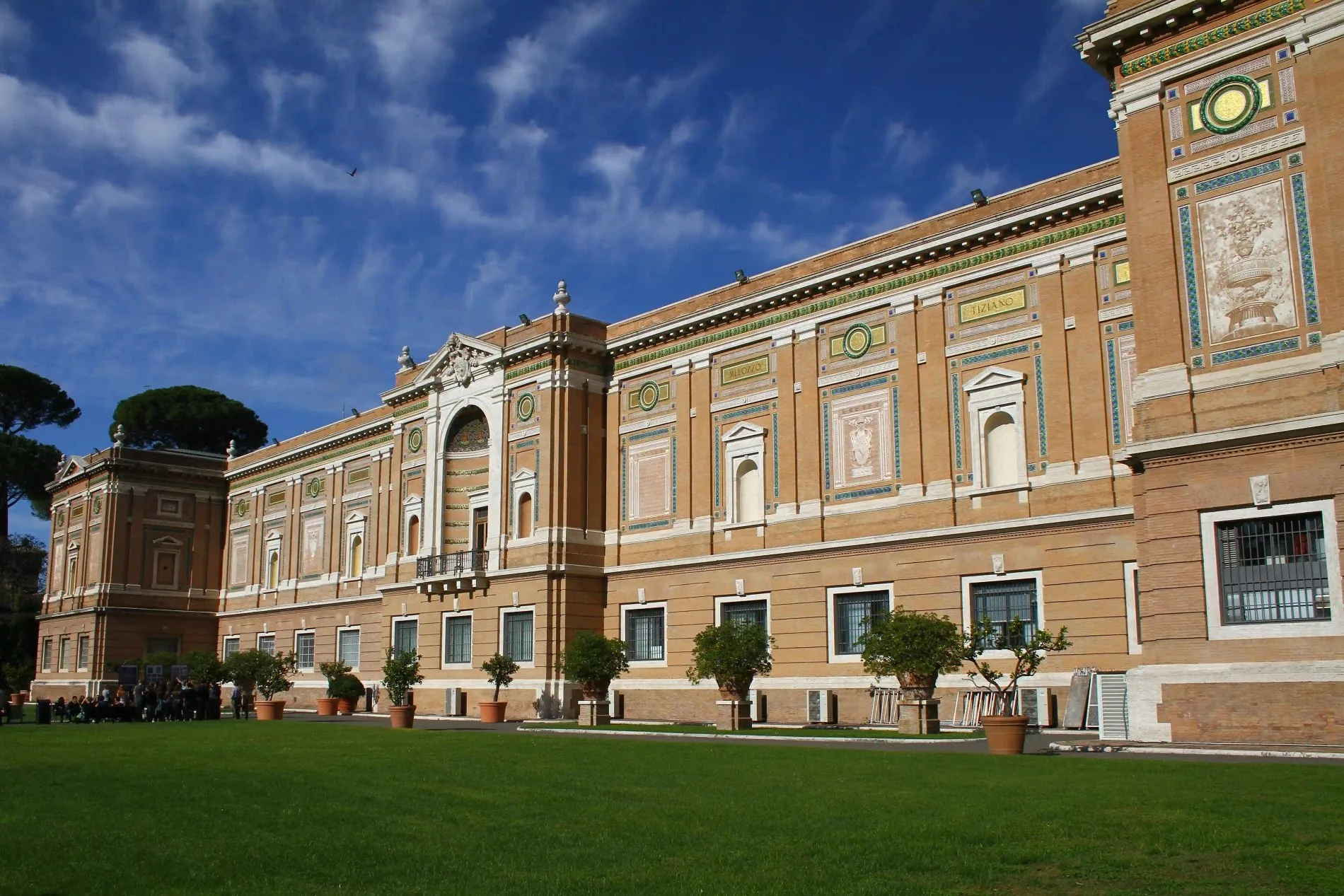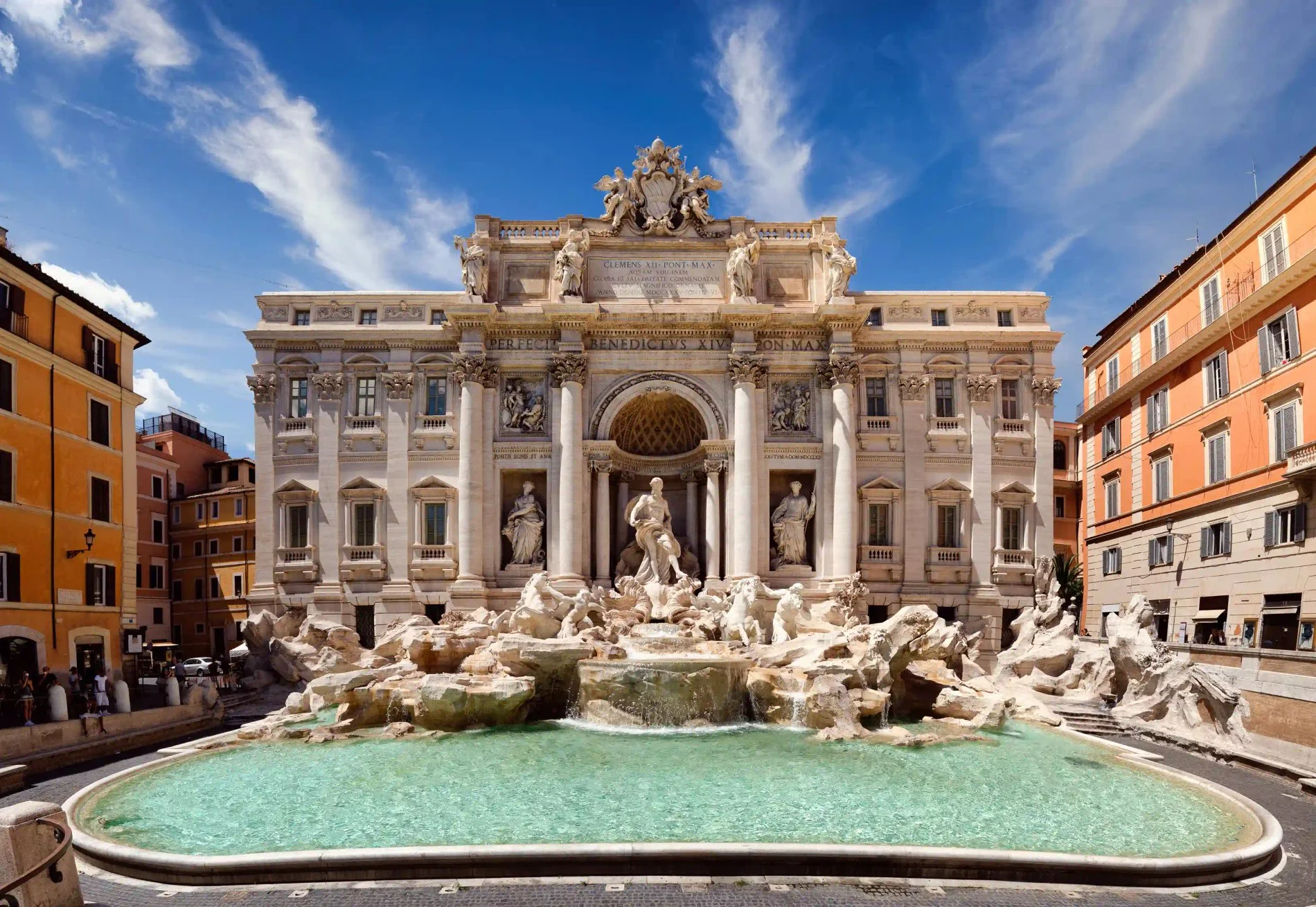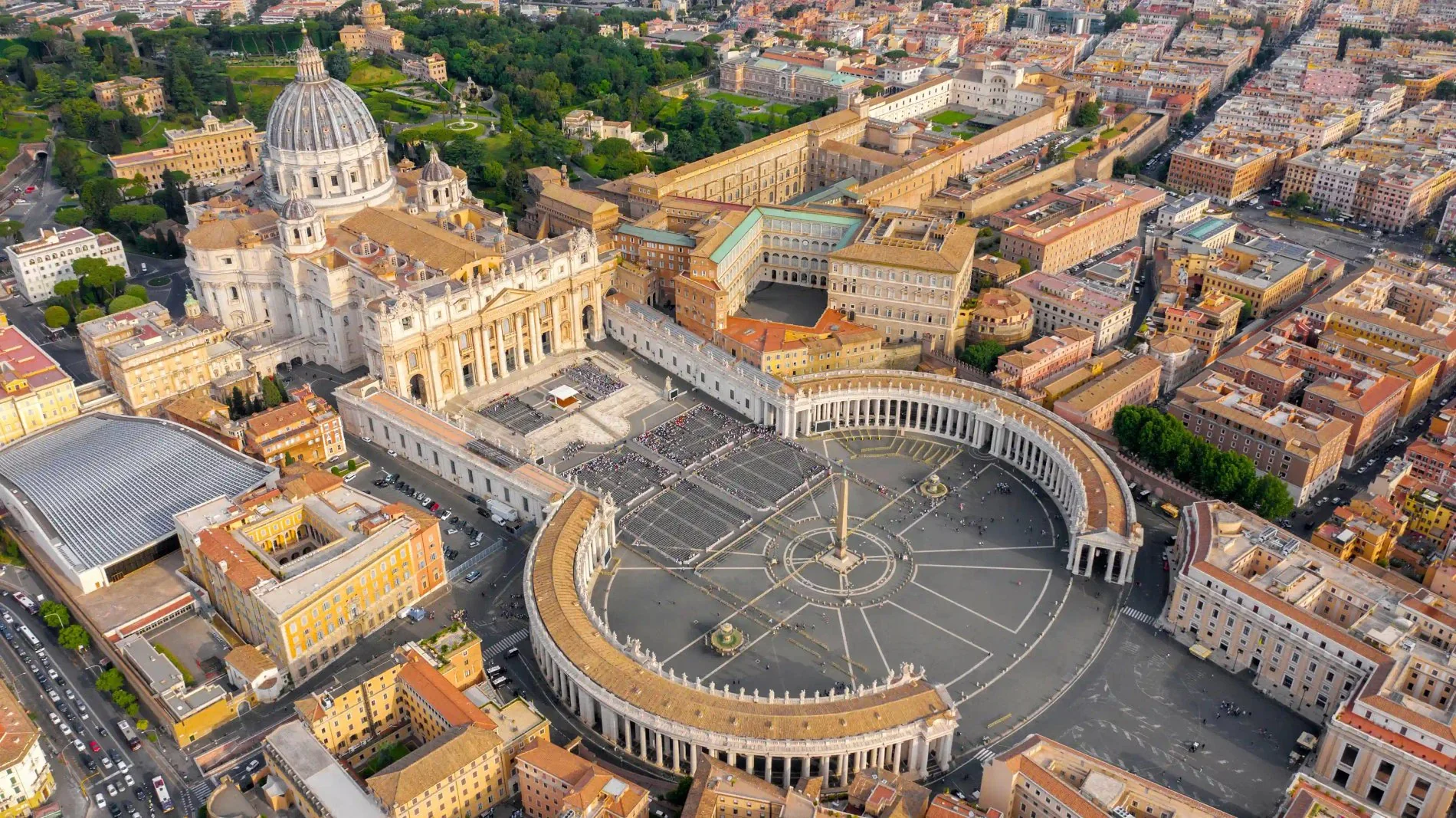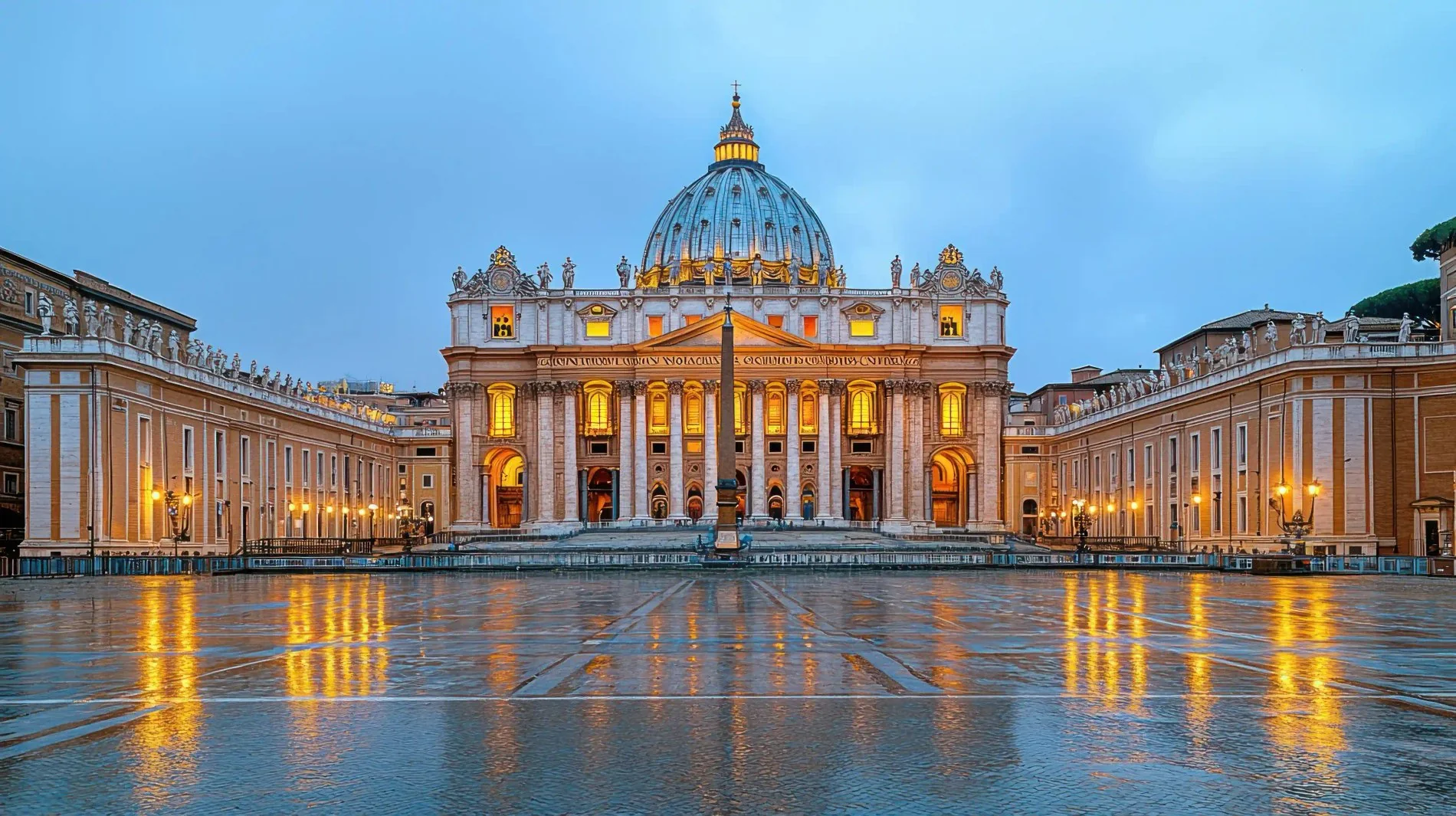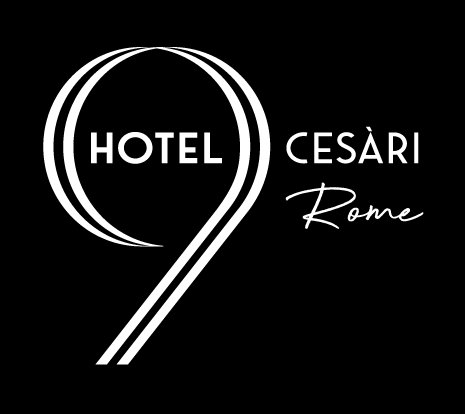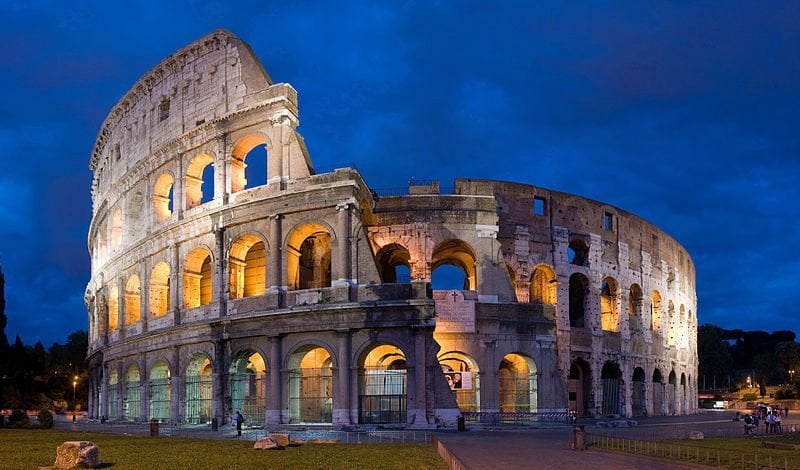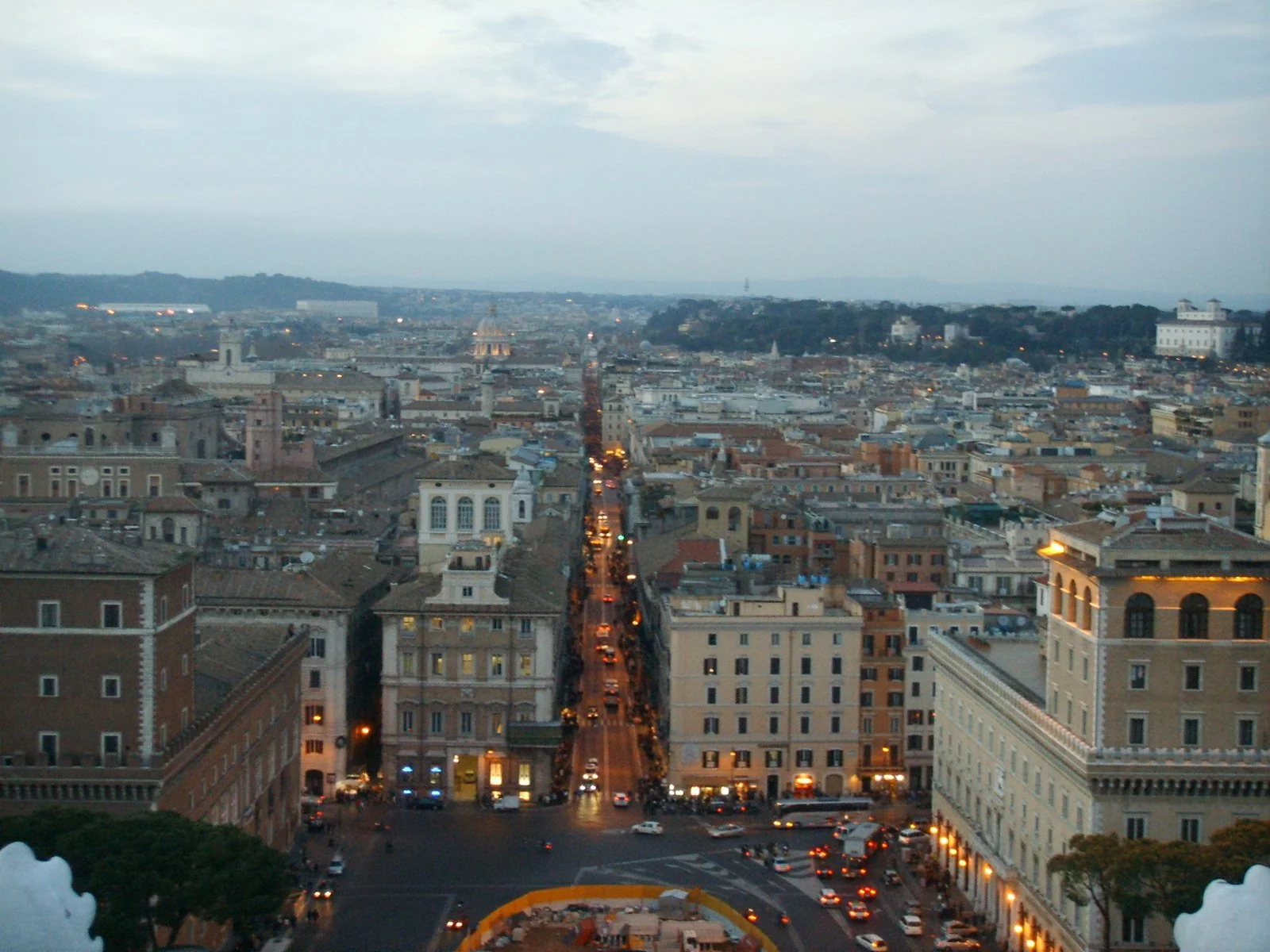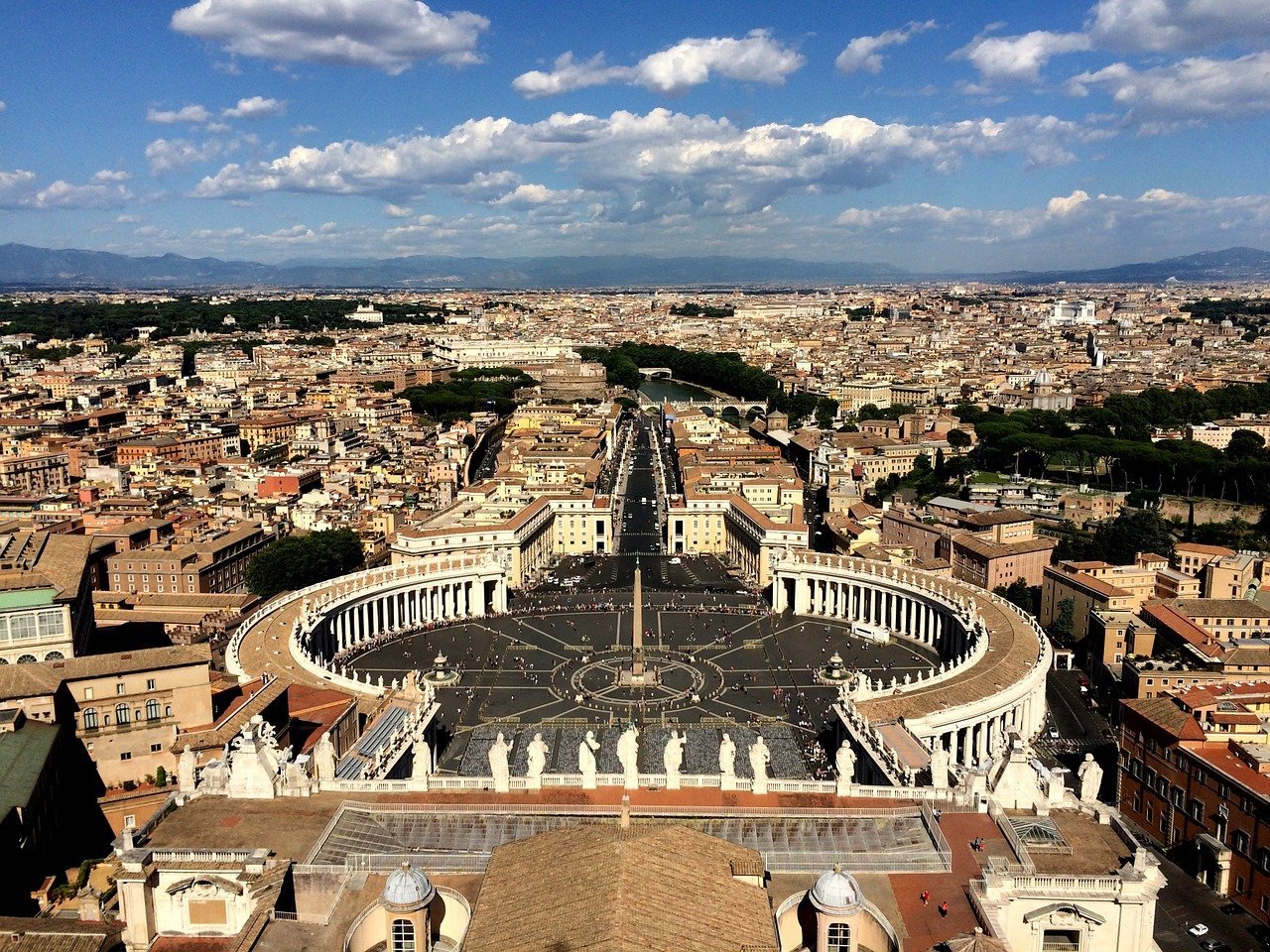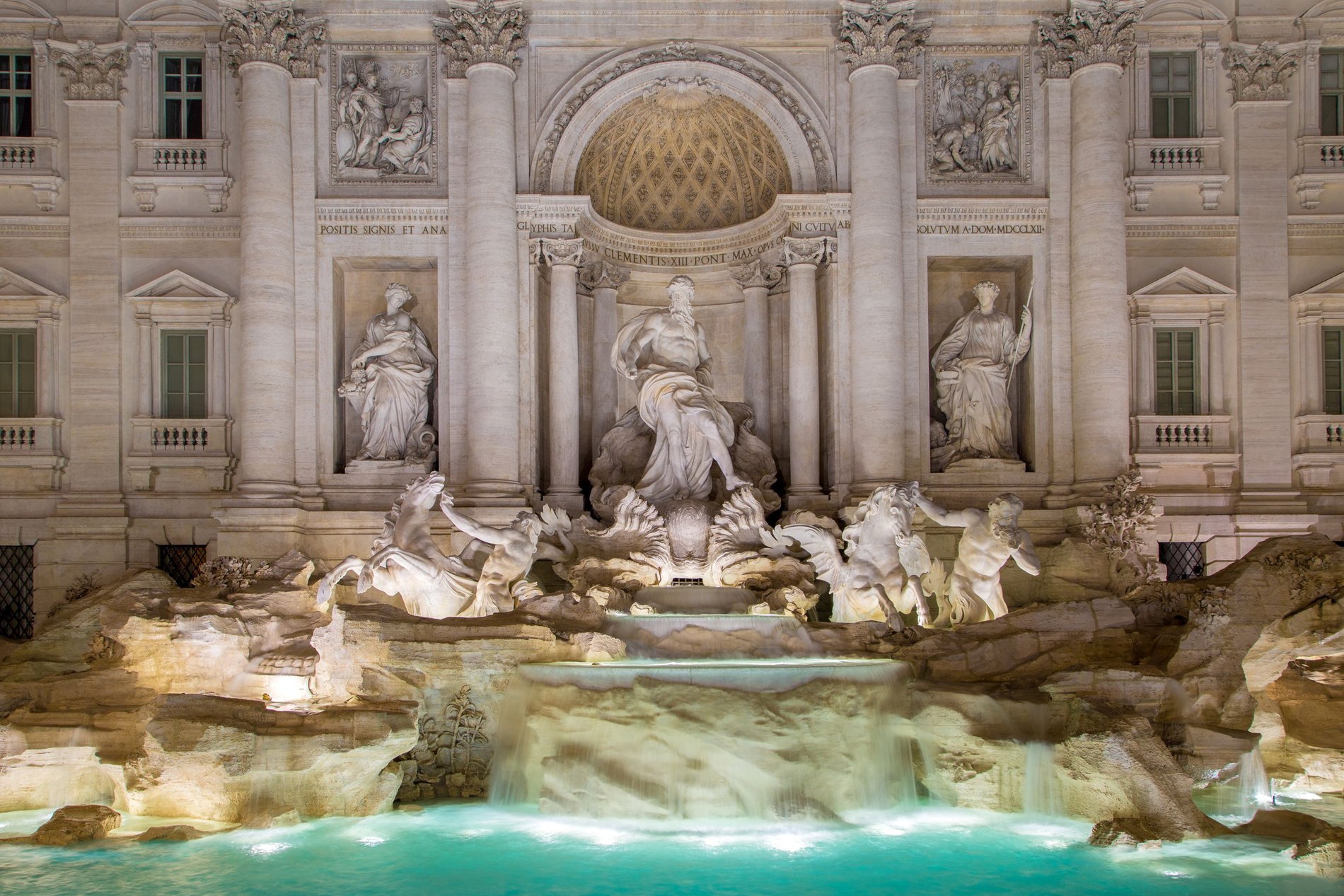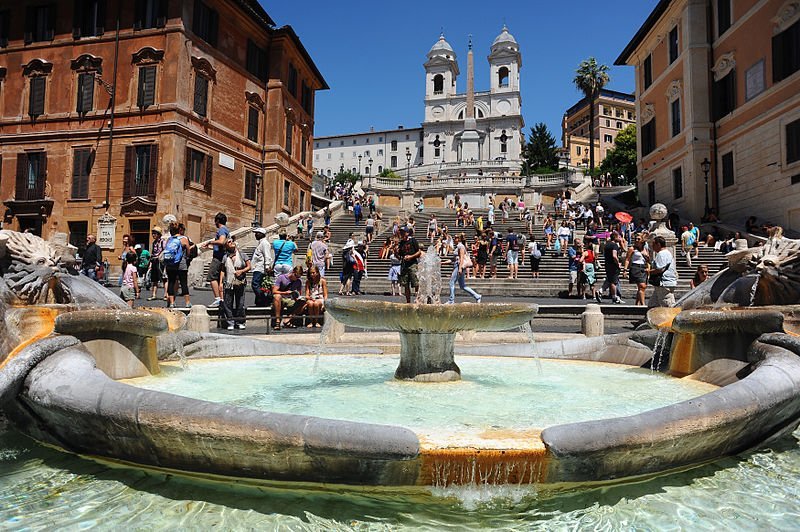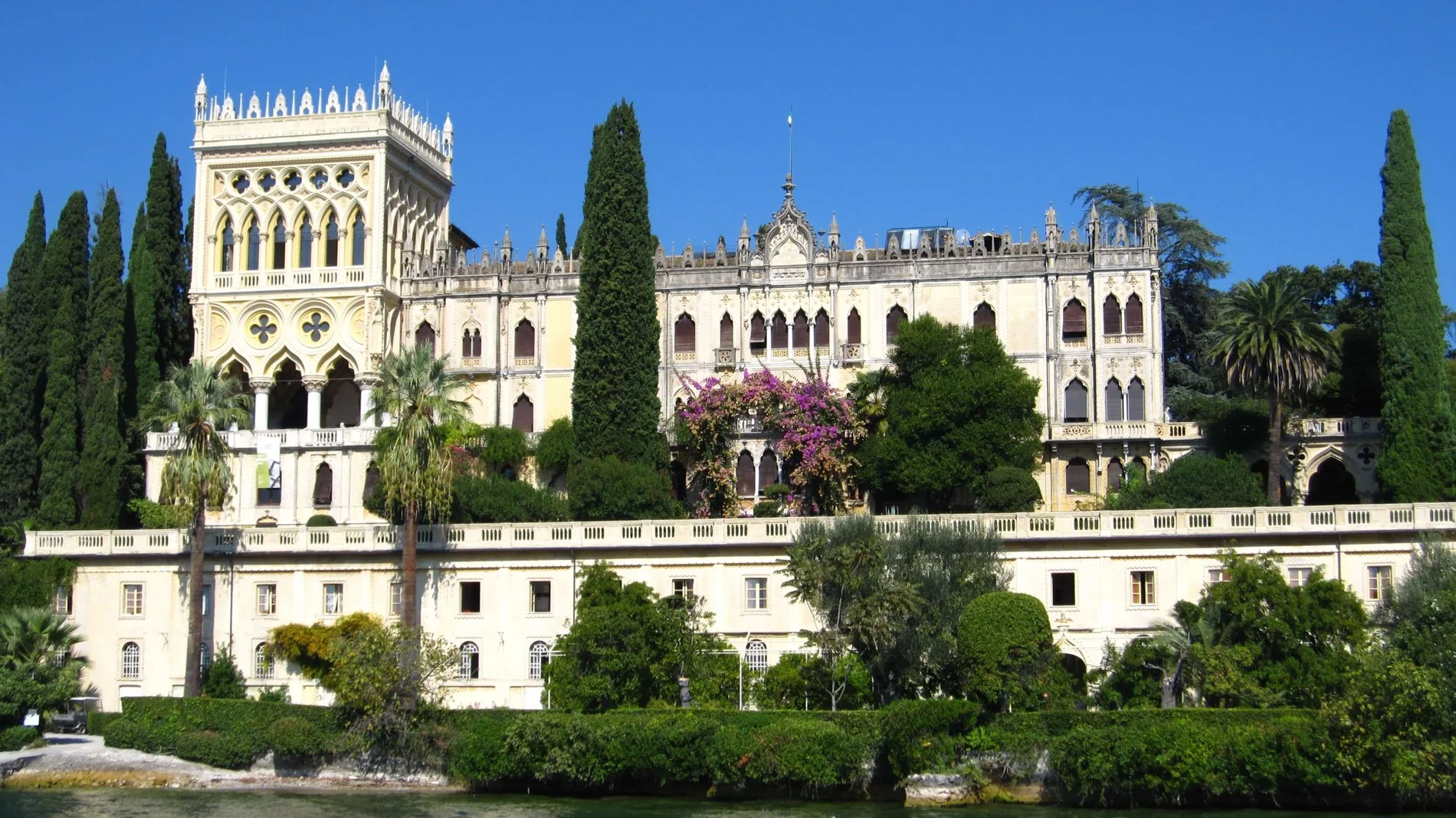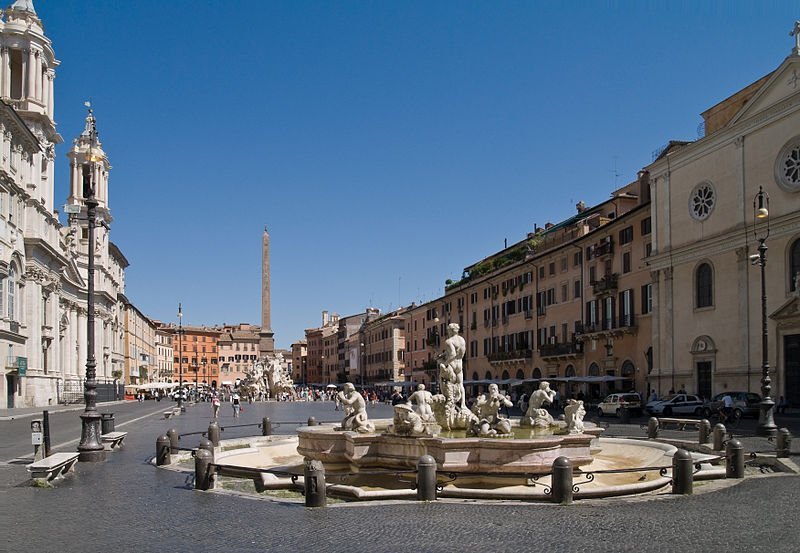Activities and tourism
Around the 9Hotel Cesàri
Discover the activities. Just a few minutes walk from the door of Hotel Cesari you will find all the main attractions close to our conveniently located hotel in Rome.
Colosseum
Colosseum
The Colosseum, an institution not to be missed during your trip to Rome
The city's mythical monument is located at the very end of the Roman forum and can be reached in a mere 20 minutes walk from our hotel. This Roman amphitheatre is one of the most massive constructions of the Roman era. This iconic site is as stunning by day as it is lit up at night. Despite its demolished appearance due to successive earthquakes, looting and the use of its precious materials for the construction of St. Peter's Basilica, the site is very well preserved. This monument is an invitation to relive the history of Rome and its gladiators.
Discover our hotel ideally located near the Colosseum
Our property is ideally located for travellers who are looking for a hotel close to the Colosseum and to visit the city on foot. Discover this grandiose monument and avoid queuing by asking our staff for advice. Line-cut tickets are available, as are guided tours. The Colosseum is open every day from 8:30 a.m., with closing times depending on the season. Please contact us for more information or to book your room in Rome and enjoy our best available price.
Rooms & Suites
The origins of the Colosseum
The Colosseum, also known as the Flavian Amphitheatre, is one of the most famous and emblematic buildings of Roman antiquity. Constructed in Rome between 70 and 80 AD, it was originally a stadium for public games and performances. The Colosseum is the largest amphitheater ever built and was used for a wide range of shows, including gladiatorial combat, chariot races and theatrical performances.
The Colosseum was built on the site of another building, Nero's Palace. This palace, built by Nero the Emperor in the middle of the 1st century AD, was his personal residence. However, after Nero's death, the palace was abandoned and eventually demolished to make way for the construction of the Colosseum.
Indeed, after the death of Nero, Emperor Vespasian decided to build the Colosseum to celebrate Rome's military victories and entertain the people. He therefore ordered the demolition of Nero's palace to make way for the construction of the Colosseum. Building materials from Nero's palace were reused to build the Colosseum, thus reducing construction costs. Vespasian restored to the Roman people this space in the heart of Rome's birthplace, a stone's throw from the Roman Forum.
Thus, the Colosseum became a symbol of the power and wealth of the Roman Empire, while Nero's palace became a mere historical anecdote. However, the destruction of Nero's palace to build the Colosseum shows Emperor Vespasian's determination to mark his reign and leave his mark on the city of Rome.
The Colosseum was able to accommodate up to 50,000 people and featured a system of marble tiers for spectators, a circular arena for the competitions and a system of tunnels for animals and gladiators taking part in the shows. The Colosseum was also equipped with an assemblage of wooden roofs that could be opened or closed according to weather conditions.
Public games were a key part of Rome's social and political life, and the Colosseum often hosted military victories and feasts. Spectators were frequently divided into different sections according to their social class allowing the wealthiest to enjoy reserved seats with an unobstructed view of the shows.
However, despite the Colosseum's political and cultural importance, public games were often criticized for their violence. Gladiatorial combat was often bloody, and wild animals were sometimes used to kill condemned criminals. As a result, many philosophers and intellectuals of the time criticized public games and their impact on Roman society.
Despite this criticism, public games continued to be held at the Colosseum until the 5th century AD, when the Roman Empire began to collapse. Over time, the Colosseum was abandoned and damaged by barbarian invasions, fires and earthquakes. However, efforts were made to restore the building, and today it is considered one of the most important monuments of Roman antiquity.
The Colosseum after the fall of the Roman Empire
The Colosseum has suffered much damage over the centuries. After the fall of the Roman Empire, it was plundered for its valuable building materials, while many elements were destroyed or damaged over time. However, despite the wreckage caused by barbarian invasions, earthquakes and fires, much of the Colosseum has been preserved and is still visible today.
Today, the Colosseum is considered a symbol of Rome's culture and history, attracting millions of visitors every year. As a UNESCO World Heritage Site, it is considered one of the most emblematic landmarks of Roman antiquity.
The Colosseum is an iconic tribute to the wealth and power of the Roman Empire.
To preserve the Colosseum for future generations, restoration and preservation efforts have been underway for several years. Restoration experts are working tirelessly to preserve the Roman masterpiece, using modern techniques to reinforce the foundations and stabilize the walls.
In addition, 3D scanning projects have been launched to create a virtual replica of the Colosseum, enabling researchers and historians to better understand how the building was constructed and how it evolved over time.
Finally, to raise awareness on the importance of preserving the Colosseum and its impact on the history and culture of Rome, education and outreach programs are in place to teach younger generations about the importance of this monument.
The Colosseum is therefore a living monument that evokes the rich and diverse history of Rome and continues to inspire people around the world. It remains a symbol of the culture and art of ancient Rome, and will continue to fascinate people for generations to come.
Roman Forum
Roman Forum
The Roman Forum, near our hotel in the historic heart of Rome
During the Roman Empire, this was the place where Roman citizens gathered to discuss business, be it political, economic, financial or other... Its location, between the Colosseum and the Capitol, makes it a heritage-rich must-see. This archaeological site forms a large rectangle reaching across these historic monuments: the Capitoline Hill, the Palatine, the Colosseum and the various imperial forums.
9Hotel Cesàri is the ideal hotel for your stay in Rome's historic center.
For your stay in Rome, do not hesitate to ask the team at 9Hotel Cesàri for advice on the best ways to discover the Roman Forum and its surroundings. Our staff can book your tickets online or help organize a group or private tour of this iconic landmark.
Our Rooms & Suites
The Roman Forum: a journey through time in the heart of Italy's capital city
The Roman Forum is accessible by bus, metro or on foot from 9Hotel Cesàri. Staying at 9Hotel Cesàri is the perfect opportunity to discover this emblematic setting and immerse yourself in Roman heritage. The history of the Roman Forum is a fascinating story that dates back many centuries. Built in the 7th century BC, it underwent several phases of development and reconstruction over time, becoming an important political and commercial center of the city.
The Roman Forum is approximately 1.2 km long and 0.8 km wide. It forms a large rectangle surrounded by historic monuments such as the Colosseum, Capitoline Hill and Palatine Hill and many peaceful gardens and greenery, providing a pleasant setting for a stroll or picnic. The ruins of the Roman Forum are scattered over a large area, with numerous temples, arcades and palaces testifying to its importance in Roman times.
Visitors can also explore the various sections of the site, such as the Foro de Cesare, the Foro de Nerva and the Foro de Trajano, each with its own unique history and architecture.The Forum, an economic, political and religious center
The Roman Forum is a place rich in history and culture. The remains here will plunge you back into Roman antiquity giving you an idea of the daily life of the citizens of the time. You will visit the ruins of temples, meeting rooms and shops, as well as the remains of roads and public squares.
The Roman Forum was also the center of public life where public assemblies, tribunals and religious processions were held. It was also the place where citizens gathered to discuss political, economic and commercial issues.
The Roman Forum was considered the political heart of public life in Rome. It was here that citizens could express themselves freely on the issues of the day, and participate in the decisions that affected their daily lives. Public assemblies were open to all citizens, and Romans could discuss their concerns with local officials, giving birth to the term "Res Publica" or "the public thing" known today as the Republic.
The location was also an important economic center for the city. Merchants set up stalls to sell their wares, and residents purchased everyday goods and services. Religious processions were also an important part of public life, with parades of statues and relics dedicated to gods and heroes.
The Roman Forum was also a place of religious worship for Roman gods. Temples were dedicated to deities such as Jupiter, Mars and Venus. There were also halls dedicated to heroes such as Romulus and Remus.
Despite the many centuries that have passed since Roman times, the Roman Forum is still visible today. Its remains are a fascinating testimony to the history and culture of Rome. Archaeologists have unearthed many interesting artefacts, including coins, statues and mosaics, all of which shed light on life in those days.
The Roman Forum and its temples
A visit to the Roman Forum is an opportunity to discover a vast selection of architectural wonders. The temples were dedicated to deities such as Jupiter, Mars and Venus, as well as heroes like Romulus and Remus. Each of these temples has a fascinating history and unique architecture.
The Temple of Jupiter Optimus Maximus is one of the most important temples in the Roman Forum. This temple was dedicated to Jupiter, the supreme Roman god. Located on the Capitoline Hill, it was considered one of the most important symbols of Roman power. The temple was decorated with numerous statues and mosaics, as well as colorful frescoes that have been preserved to this day.
The Temple of Vespasian is another important temple in the Roman Forum. This temple was dedicated to Vespasian, the Roman emperor who reigned from 69 to 79 AD and was responsible for the construction of the Colosseum. The temple was located in a large inner courtyard and was decorated with colorful frescoes depicting scenes from Vespasian's life.
The Temple of Saturn is another interesting example of Roman architecture. This temple was dedicated to Saturn, the Roman god of sowing and harvesting. Located in the Roman Forum, it was surrounded by massive columns and thick walls. The temple was also decorated with statues and mosaics depicting scenes from the life of Saturn.
The Roman Forum is a peaceful and tranquil place, surrounded by greenery and gardens. It's an ideal place to relax and recharge your batteries after a busy day of sightseeing. One can sit on the benches and enjoy the view of the Roman remains, or simply stroll through the gardens and admire the scenery.
Historical and geographical proximity to the Palatine Hill
The Roman Forum is also closely linked to Mount Palatine, another important historical site in Rome. Mount Palatine was considered the city's birthplace, as it was here that Rome's first inhabitants established their colony. Over time, Mount Palatine became an important political center of the city, with many residences of emperors and nobles.
Mount Palatine is also linked to the Roman Forum by its architecture. The two sites share a similar aesthetic, with massive columns, thick walls and colorful frescoes. Roman architects used the same techniques to construct buildings on the Palatine and in the Roman Forum, giving the city an architectural coherence.
Visiting Mount Palatine and the Roman Forum together gives one the opportunity to discover the history of the city of Rome, from its origins to its apogee as the political and commercial center of the Roman Empire. You can also admire the different architectural styles, from religious temples to the residences of emperors and noblemen.
Mount Palatine and the Roman Forum are closely linked by their history and architecture.Both sites offer a fascinating insight into life in Rome in different eras, and are a must-see for history and culture buffs.
The Roman Forum in popular culture
The Roman Forum is also a film location for many movies and TV series. Filmmakers appreciate the authenticity of the location to recreate scenes from historical eras. Movie fans might recognize some of the sites in the Roman Forum from films such as "Gladiator" or "Ben-Hur".
While visiting the Roman Forum, you will also have the opportunity to discover historical monuments nearby. The Colosseum is one of Rome's most famous landmarks and a must-see for history buffs. The Capitoline is another important monument, with its imposing architecture and peaceful gardens.The Roman Forum is also within easy reach of numerous restaurants and bars. You can sample traditional Roman cuisine in one of the city's many restaurants, or relax with a glass of wine in one of the local bars. Nightlife in Rome is very rich and you can enjoy live music, dancing and good food all night long.
9Hotel Cesàri is the ideal place for your stay in Rome and can help you plan your visit to this archaeological site. Don't hesitate to book your room today to make the most of your stay in Rome.
Ponte Sisto
Ponte Sisto
The 9Hotel Cesari is located near Ponte Sisto in Rome
For an exceptional Roman vacation, choosing a hotel near the Ponte Sisto is a smart choice. Located right in Rome's city center, it offers visitors the chance to discover the Italian capital on foot, strolling through the maze of pretty cobbled streets to explore the city's most beautiful monuments, such as the Pantheon, 300m from the hotel, or the Trevi Fountain, also located at the same distance from the hotel.
Discover both banks of the Tiber
Rome's famous Ponte Sisto bridge crosses the Tiber. It links two rioni (regions): Rigola and Trastevere. A beautiful stone bridge, tourists to Rome like to stay in a hotel close to the Ponte Sisto to enjoy the view of the river banks. A lively and festive district, the bridge is reserved for pedestrians, who enjoy strolling along it to photograph the banks of the Italian capital and take in the invigorating air. Today's Ponte Sisto, which was completed in 1979, takes its name from Pope Sixtus IV and is one of the jewels in the crown of the city's rich architectural heritage. On one side, Rigola with its numerous churches and Piazza Farnese. On the other, Trastevere, with its churches, fountains, museums and fine palaces such as San Callisto and Palazzo Corsini.
History of the Ponte Sisto
The history of the Ponte Sisto dates back to ancient Roman times, when the city was still expanding and needed a way to cross the Tiber to link the various districts. The first bridge on this site was built in the 6th century BC and was made of wood. This bridge was destroyed and rebuilt several times over the centuries, until finally, a stone bridge was built in the 1st century BC.
During the Middle Ages, the stone bridge was extensively damaged by barbarian invasions and civil wars. It was rebuilt and enlarged in the 14th century to allow the passage of carts and horsemen. By the 17th century, however, the bridge was again in poor condition and was extensively rebuilt by Pope Innocent X.
The Ponte Sisto we know today was built in the 19th century on the foundations of the previous bridge. It was designed by the architect Pontefice and inaugurated in 1884. The bridge was built in stone and iron, giving it a more modern and solid appearance than its predecessors.Over the years, the Ponte Sisto has undergone numerous changes and improvements. During the Second World War, the bridge was severely damaged by Allied bombing, but was quickly restored after the end of the war. Over the following decades, renovation work was carried out to improve safety and traffic flow on the bridge.
Today, the Ponte Sisto is one of Rome's busiest bridges, welcoming thousands of people every day. It is considered a symbol of the city and is a popular spot for strolling and sightseeing. Along the bridge, you can admire numerous historic buildings and breathtaking views of the Tiber and the city.
The Ponte Sisto is a historic and culturally important bridge in Rome, spanning over 2,000 years of history and change. Despite the challenges it has faced over the years, it remains a symbol of the city and a popular tourist attraction. It attracts thousands of visitors every year, who come to admire its architectural beauty and rich history. What's more, the Ponte Sisto is an important link between Rome's different districts, connecting Trastevere to the Isola Tiberina and enabling the city to grow and prosper over the centuries. Ultimately, the Ponte Sisto is a key part of Rome's history and culture, and continues to be a meeting and gathering place for the city's inhabitants and visitors alike.
The Ponte Sisto in Italian popular culture
Many artists, including poets, painters and musicians, have evoked the Ponte Sisto in their works.
Roman poet Gabriele D'Annunzio wrote a poem entitled "Il Ponte Sisto", celebrating the bridge's beauty and its place in the city's history. Other poets, such as Giuseppe Gioachino Belli and Trilussa, also wrote about the bridge and its associations with everyday life in Rome.
Many painters were also inspired by the Ponte Sisto and included the bridge in their works, including many Renaissance artists such as Caravaggio and Bernini. The bridge is often depicted in paintings as an important element of the city and its urban landscape.
The bridge is often mentioned in Italian popular music, particularly in songs about the city of Rome. Local musicians often evoke the bridge in their works, celebrating its beauty and importance to the city.
The Ponte Sisto is also associated with many important cultural and social events, such as city festivals and local celebrations. It is frequented by the people of Rome for activities such as family walks, picnics and group parties. The bridge is also a popular spot for lovers, who often come here at night to admire the views over the city and the Tiber.
Finally, the Ponte Sisto is a meeting place for street artists, such as musicians, painters and photographers, who come here to showcase their work and talent. The bridge is considered an open public space for creativity and artistic expression, making it a unique and special place in Italian popular culture.
The Ponte Sisto is an emblematic place in Italian popular culture, mentioned in numerous works of art, associated with many important cultural and social events, and considered a public space for creativity and artistic expression.
Ponte Sisto is often featured in films and television productions. As one of Rome's most emblematic bridges, it provides a romantic and historic backdrop for scenes of the city. It is often used to represent the city in films set in Rome or with scenes set in the city.
Many popular films have used the Ponte Sisto as a backdrop for romantic scenes, offering breathtaking views of the Tiber and the city. The bridge has also been used for chase and action scenes, due to its proximity to other important historical and tourist sites in the city.
Finally, the Ponte Sisto is also often included in Rome's tourist filming, where it is presented as an important historical and cultural landmark of the city.
Rome at night
Staying in a hotel near the Ponte Sisto is also an opportunity to take a pleasant stroll. At night, the bridge is fully illuminated, offering a different view of the city. Majestic during the day, it is adorned with mystery at night, providing a special emotion. It's a favorite spot for Romans and tourists alike, who love the romantic atmosphere. At the foot of the bridge, frescoes by William Kentridge depict the history of Rome and complete the impression of the Italian city's grandeur. A meeting place par excellence, in the evenings amateur musicians come here to play a few scores, contributing to the charming and picturesque image of a city that never sleeps. Street performances also enliven the banks of the Tiber to the delight of strollers.
Rome on foot
Our hotel near the Ponte Sisto in Rome allows you to enjoy many of the capital's sights within easy walking distance. Close to the Palazzo Spada and the Navona district, the Ponte Sisto tells stories. The Palazzo Spada, a superb Roman building, houses an incredible collection of paintings in spectacular Baroque style. Just a few minutes away is the charming Navona district, offering visitors small squares, fountains and churches that are still very typical of Italy. The atmosphere in the narrow streets is pleasant day and night. A short walk from the hotel will also take you past the famous Pantheon. The city's tourist heart par excellence, it's within easy reach of the 9Hotel Cesàri. It's one of the oldest and most beautiful districts of the Eternal City.
Via del Corso
Via del Corso
The 9 Hotel Cesari is located near Via del Corso in Rome
Rome, a magnificent, romantic city. Known worldwide for its majestic monuments and its culinary delights. It is also renowned for the friendliness and frankness of its inhabitants and its numerous tourist attractions. Staying in a hotel near Via del Corso in Rome allows you to bask in the Italian capital's splendor. Walking along the Via del Corso also offers easy access to the Trevi Fountain on one side and the Pantheon on the other, both historic must-see landmarks just minutes away from the 9Hotel Cesàri.
Traversing Majestic Rome
Guests at our hotel near Via del Corso in Rome enjoy strolling from one square to another. This major thoroughfare extends from the stunning Piazza Venezia towards Piazza del Popolo. Between these two main squares, you'll encounter fountains, churches, cobblestone alleys, and colorful side streets that give Rome its unique charm. As a quintessential historic district, there are numerous palaces on this side of the city, including Palazzo Chigi, Palazzo Rispoli, and Palazzo Doria-Pamphili. The Goethe House, now a museum dedicated to the German writer, is also located in the area.
One of the hallmarks of Via del Corso is its elegant architecture, reflecting Rome's diverse historical eras. The street boasts Renaissance, Baroque, and Neoclassical buildings, as well as historic landmarks such as the Church of Sant'Andrea della Valle and Piazza Colonna. Moreover, Via del Corso is lined with high-end fashion boutiques like Gucci, Prada, and Armani, and a plethora of souvenir shops for tourists.
Shopping in Rome
For an authentic vacation in the Italian capital, staying in a hotel near Via del Corso grants access to Rome's bustling neighborhoods. As a premier shopping street, fashion enthusiasts flock here to discover the latest collections. A neighborhood that's simultaneously upscale, trendy, and popular, it embodies a blend of styles unique to Italy. Stretching 1.5 kilometers, Via del Corso is a classic, yet essential, tourist stroll. Amidst the boutiques and beautiful churches, numerous restaurants serve regional gourmet specialties. Stopping to savor pasta or pizza is almost obligatory for hungry visitors after their explorations.
Linking Two Major Squares
After shopping, tourists in Rome often seek out other attractions. In this Italian city, there's no shortage. For those staying near Via del Corso in Rome, the surrounding beauty is captivating. The street provides a seamless blend between two of Rome's iconic squares. On one side, the colossal monument dedicated to Victor Emmanuel II offers panoramic views of Rome and Via del Corso. On the other, the Heliopolitan Obelisk stands tall, with the stunning Villa Borghese gardens nearby offering another idyllic viewpoint of the Italian capital. Rome invites leisurely strolls, and around every corner, another Roman marvel may await. Lodging near Via del Corso places visitors at the heart of Italy's capital, perfect for exploring its wonders.
History of Via del Corso
The history of Via del Corso dates back to Ancient Rome when it was used for horse racing and public processions. Over the centuries, it evolved into a bustling shopping street, offering a variety of goods for both Romans and tourists. The 19th century witnessed an architectural resurgence, with additions like the National Central Library and Valle Theatre, reaffirming its role as the city's cultural hub.
Via del Corso in Italian Literature
Over the ages, Via del Corso inspired many renowned authors, who wrote about life on this vibrant Roman street.
19th-century Roman poet Giuseppe Gioacchino Belli penned several poems about Via del Corso, capturing its daily life, lifestyles, and customs. These works remain treasured records of the street's history.
20th-century Italian writer Federico De Roberto drew inspiration from Via del Corso, crafting a novel, "I Vicerè," which depicts life in a 19th-century aristocratic Roman family. The book references Via del Corso as the city's social epicenter, brimming with cafes and theaters.
Moreover, due to its stature as a cultural nucleus in Rome, the street is home to several theaters, such as Valle Theatre and Argentina Theatre, which have staged numerous plays and musicals over the years.
A Hub for Political Activism
Via del Corso has witnessed many pivotal political events, including the popular rally supporting Italian unification in 1848.
This unification was a complex historical process in the 19th century, merging various regional states into a unified Italian nation. Before unification, Italy was a patchwork of distinct states, such as the Kingdom of Sardinia, the Grand Duchy of Tuscany, and the Kingdom of the Two Sicilies. However, by mid-century, a burgeoning movement led by figures like Camillo di Cavour and Giuseppe Garibaldi emerged, championing national unification.
The 1848 Via del Corso rally marked a crucial moment in this evolution. Primarily composed of ordinary citizens, demonstrators gathered on the street to voice their support for a united Italy and protest against the local governments resisting the idea.
Ultimately, Italian unification culminated in 1870 when the Kingdom of Sardinia was proclaimed the Kingdom of Italy. Since then, Via del Corso has remained integral to the city's and nation's political life, hosting countless political events and bearing witness to modern Italy's unfolding history.
Moreover, over the years, Via del Corso has been the epicenter of various political and social demonstrations, echoing Rome's lively spirit and strong public sentiments. The city streets, including Via del Corso, have always served as rallying points for Romans, where they can express their opinions and political convictions.
Vatican Museum
Vatican Museum
Take advantage of your stay at our charming hotel in Rome and set out to explore the Vatican
Vatican City is an independent, recognized state under the sovereignty of the Holy See, where the Pope of the Catholic Church reigns as an absolute monarch. With an area of just 0.44 km2, it's the smallest state in the world with 824 residents recorded in 2008. Yet, despite its tiny size, this state has its own printing press, publishing works in many languages and even has a daily and a weekly newspaper. It also has its own stamps and mints its currency, usable throughout the rest of Italy. Vatican City is a unique place in Rome and indeed the world. Located near the Tiber River, which flows through the heart of Rome, it's one of the most magical places to visit. The St. Peter's Basilica, its palaces, and stunning gardens make it truly special. Be sure to book your tickets well in advance, as visiting is a must for every tourist in Rome.
The 9Hotel Cesàri is perfect for your Vatican visit
On the last Sunday of each month, except in June and July, the museums are open for free from 9 am to 2 pm (last entry at 12:30 pm). Our 4-star hotel in the heart of Rome is just a 25-minute walk from the Vatican. The walk is delightful as you will cross Rome's historical center, passing through Piazza Navona and then onto the "Vittorio Emanuele II" bridge, leading straight to the Vatican. Don't hesitate and book at the best rate for your stay in Rome.
Several museums are located within Vatican City. Here's a list of the most significant and renowned ones.
Vatican Museums and their Collections
Vatican Museum
This museum houses a vast collection of art and antiquities, including paintings, sculptures, mosaics, tapestries, and ancient manuscripts. Founded in 1506 by Pope Julius II, it was opened to the public in 1747. Located within Vatican City, the museum boasts over 50,000 objects, ranging from paintings, sculptures, mosaics, tapestries, ancient manuscripts, and much more.
One of the museum's top attractions is the Gallery of Maps, which holds a collection of ancient geographic maps and detailed wall maps. There's also the Hall of Candelabras, which features a collection of antique sculptures, as well as the Sistine Chapel, one of the world's most renowned buildings.
The Vatican Museum is also known for its religious art collections, including paintings by Raphael and Caravaggio. There's a significant collection of Egyptian, Greek, and Roman art, as well as Asian and African art pieces.
Generally, the Vatican Museum is a must-visit for art and history enthusiasts, providing a unique opportunity to explore humanity's artistic and cultural heritage.
Sistine Chapel
The Sistine Chapel is among the world's most famous and important religious structures. It's situated in the Apostolic Palace, the Pope's official residence, and the seat of the Vatican City state's government. The chapel was commissioned by Pope Sixtus IV in the 15th century and was consecrated in 1483.
Most notably, the Sistine Chapel is adorned with exquisite frescoes painted by the era's greatest artists, including Michelangelo, Raphael, and Sandro Botticelli. These frescoes cover the walls and the ceiling, depicting biblical and religious scenes, like the creation of Adam and the Last Judgment.
Besides its paintings, the Sistine Chapel is renowned for its sculptures, mosaics, and ornate stuccos. The chapel's furniture, including the papal seat, is magnificent, epitomizing Renaissance wood carving artistry.
Vatican Pinacoteca (Art Gallery)
The Vatican Pinacoteca is an art gallery situated within Vatican City in Rome, Italy. Established in the 19th century, it houses an impressive collection of Italian Renaissance paintings and sculptures, as well as other significant art pieces.
The gallery is especially renowned for its Italian Renaissance painting collections, featuring works by illustrious artists like Raphael, Caravaggio, Fra Angelico, and Fra Bartolomeo. The paintings span various subjects, from portraits and religious scenes to landscapes and still lifes.
In addition to paintings, the Vatican Pinacoteca also contains a collection of ancient sculptures, including pieces from ancient Greece and Rome. It has a foreign art collection too, comprising European and Asian paintings and sculptures.
A work by Leonardo da Vinci, "Saint John the Baptist," is also displayed in the Vatican Pinacoteca. This painting depicts Saint John the Baptist in a desert landscape, his arms raised prophetically.
While Leonardo da Vinci is predominantly renowned for his inventions and contributions to science, he's also esteemed as one of history's greatest artists. His "Saint John the Baptist" painting exemplifies his creative genius and his skill in capturing human nature's beauty and intricacy.
Gregorian Egyptian Museum
Dedicated to ancient Egyptian art and culture, the Gregorian Egyptian Museum is part of the Vatican Museums. Established in the 19th century by Pope Gregory XVI, from whom it takes its name, the museum has since grown and enriched with new acquisitions and donations. Today, it's one of the world's foremost Egyptian art museums, drawing thousands of visitors yearly.
It's particularly acclaimed for its collection of Egyptian sculptures, including statues of pharaohs, gods, and goddesses. There's also a significant collection of Egyptian paintings, comprising mural paintings and papyrus paintings. Everyday objects like jewelry and household items offer a captivating glimpse into ancient Egyptian life.
Chiaramonti Museum
This museum houses a collection of ancient sculptures, featuring works from ancient Greece and Rome.
Established in the 19th century, the Chiaramonti Museum is named after Pope Pius VII, known as Chiaramonti before his papal election. The museum was designed to accommodate a collection of ancient sculptures amassed by the Popes over centuries.
It boasts an impressive collection of ancient sculptures, including statues of gods and goddesses, portraits of prominent Roman citizens, and busts of famous personalities from antiquity. Displayed works span from ancient Greece to ancient Rome, offering a riveting insight into the art and culture of the ancients.
All these museums are essential visits during your day at the Vatican, equally as indispensable as the famous St. Peter's Basilica, guaranteeing a packed day!
Don't hesitate to seek advice from the teams at the 9Hotel Cesàri. They'll be more than happy to assist you in preparing for your visit.
Trevi Fountain
Trevi Fountain
Discover the Trevi Fountain, which is only a stone's throw from our hotel in the centre of Rome
It's Rome's most famous church, and a must-see! Built at the request of Pope Clement XII, it was completed in 1762. The Trevi Fountain dates back to 1453, when it was the mouth of a Roman aqueduct that brought water from a spring built in 1453. Tradition has it that you throw 2 coins over your left shoulder into the fountain, one to make a wish, the other to make sure you get back to Rome. This fountain, the largest in the city, is located near the Pantheon. It backs onto the palace, once the residence of the Dukes Poli, now the Italian Polygraphic Institute. The arch behind it is reminiscent of the entrance to a temple. The Trevi Fountain was designed and built in honor of the god of the seas, Neptune. Measuring 20 meters wide by 26 meters high, it depicts Neptune on a chariot, drawn by two horses guided by tritons. The 9Hotel Cesàri in Via di Pietra is just a few minutes' walk from the Trevi Fountain. Take advantage of your stay at our hotel to explore the city and discover all its secrets. Whatever the reason for your stay, you're sure to find the best offer on our website!
Staying near the Trevi Fountain: the 9Hotel Cesàri
To make the most of your visit to the Trevi Fountain and the historic center, the 9Hotel Cesàri is the ideal base. Located on Via di Pietra, just a few minutes' walk from the monument, our 4-star hotel is one of the oldest in Rome. Today, it combines its period architecture with modern décor.
A real asset to our establishment, the rooftop allows you to appreciate the city from a different angle. This vast terrace offers a panoramic view over the rooftops of Rome, a pleasant setting for a quiet breakfast or Sunday brunch. The place also comes alive at the end of the day: the bar welcomes visitors for a moment of relaxation, accompanied by music on Friday and Saturday evenings.
Our Rooms & Suites
In terms of accommodation, the hotel offers a range of options, from classic rooms to family suites, allowing guests to rest comfortably after a day of sightseeing.
The origins of a symbol of Rome
The origins of the Trevi Fountain date back to 1453, when the mouth of a Roman aqueduct was built to bring water from a spring located a few kilometers from the city. Over the centuries, the fountain became a meeting and gathering point for the Romans, a place to drink, wash and even pray.
The Trevi Fountain is also a place steeped in legend and tradition. According to legend, the fountain was built on the site where a young girl was said to have indicated to Roman soldiers the location of a water source. The girl was then transformed into a nymph, who would watch over the spring for eternity. This legend gave rise to a popular tradition according to which, if you throw a coin into the fountain, you're guaranteed to return to Rome one day.
When you visit the Trevi Fountain, you'll be able to admire the incredible sculptural and architectural work that went into creating it. The details are impressive, from horses and tritons to shells and other decorative elements. The fountain is a true work of art, a testament to the ingenuity and talent of the artists who created it.
The Trevi Fountain in Rome's recent history
Today, the Trevi Fountain is a symbol of the city of Rome, a must-see tourist attraction that attracts millions of visitors every year. Tradition has it that you throw two coins over your left shoulder into the fountain, one to make a wish, the other to make sure you return to Rome. The practice has become so popular that the fountain is regularly emptied to collect the coins, which are then used to fund charity projects.
But the Trevi Fountain is much more than just a tourist attraction. It is a symbol of Rome's history and Italian culture. It recalls Roman and Baroque times, legends and traditions. It embodies the beauty and grandeur of the city of Rome, a city that has inspired the greatest artists and writers in history.
The Trevi Fountain has also inspired many artists. Federico Fellini's famous film "La Dolce Vita" was filmed largely at the fountain, helping to reinforce its international reputation. Writers such as Mark Twain and Henry James have also written about the fountain, captivated by its beauty and history. In addition to artists, the Trevi Fountain has also attracted many writers and intellectuals over the years. The likes of Goethe, Stendhal and Byron have all written about the fountain, fascinated by its beauty and history. The English Romantic poet John Keats even wrote a famous poem entitled "Ode to a Nightingale" about the Trevi Fountain.
Over the years, the Trevi Fountain has become a place of celebration for Romans. Weddings, christenings and other joyous events are often celebrated around the fountain, which provides an idyllic backdrop for these special occasions.
Despite its popularity, the Trevi Fountain has also been the scene of many conflicts and controversies. Over the years, it has been the gathering place for political and social demonstrations, and the scene of many violent incidents. In 1979, a group of anti-fascist activists marched around the fountain, provoking riots with far-right groups.
Over the centuries, it has been the scene of numerous events, from political rallies to riots and popular revolts. In 2007, the fountain was at the center of a controversy when tourists were accused of stealing coins from the fountain, damaging its beauty and integrity.
The Trevi Fountain has also been at the center of debates around the preservation of Italian history and culture. In 2017, activists launched a campaign to prevent the fountain from being used as a filming location for a fashion commercial. Activists argued that the fountain was a symbol of Italian culture and should not be used for commercial purposes.
Despite these controversies, the Trevi Fountain continues to attract millions of visitors every year. Tourists can admire the fascinating details of the architecture and sculpture, toss in a coin to make a wish, or simply stroll around the area and discover the city's other treasures.
While visiting the Trevi Fountain, you can also discover the many other treasures of the city of Rome. The Pantheon, close to the fountain, is another example of Roman and Baroque architecture, with its impressive dome and columned courtyard. The Colosseum, the Roman Forum and the Vatican with its Basilica of St. Peter are other must-see attractions in the city, bearing witness to the history and grandeur of the Roman Empire.
But there's more to Rome than its monuments and history. The city is also famous for its cuisine, fashion and culture. The streets of Rome abound with restaurants serving authentic Italian cuisine, from family-run pizzerias to elegant trattorias. Fashion boutiques, art galleries and museums also offer a unique cultural experience, combining tradition and modernity.
Finally, Rome is also a lively and festive city, where cultural events and festivals take place all year round. From classical music concerts to fashion shows, film festivals and art fairs, there's always something to see and do in Rome.
The Trevi Fountain in Roman popular culture
The Trevi Fountain is also a meeting place for Romans. Locals like to gather around the fountain to refresh themselves, chat with friends or simply contemplate the beauty of the architecture. Summer evenings are particularly lively, with bands, street performers and ice-cream vendors gathering around the fountain.
The Trevi Fountain is also a place of spirituality and contemplation for many. Pilgrims and believers can meditate around the fountain and connect with their spirituality. The fountain is also a place of prayer for Catholics, who can light candles and recite prayers for their loved ones.
The Trevi Fountain is a magical place to visit when in Rome. It is a symbol of the city's history, culture and beauty. From its conception to its construction, restoration and maintenance, the Trevi Fountain embodies the very essence of the city of Rome.
Practical aspects of visiting the fountain
If you're planning a visit to the Trevi Fountain, there are a few practical aspects to bear in mind. The fountain is located in a very touristy area and can be very busy during peak hours. It is therefore advisable to visit the fountain early in the morning or late at night, when the crowds are smaller. You can also relive the cult scene from Fellini's Dolce Vita by visiting it at night.
When visiting the Trevi Fountain, be sure to observe the rules of good behavior. Avoid throwing litter into the fountain and make sure you don't disturb other visitors. Also, make sure you don't damage the fountain by climbing on it or touching the sculptures.
Finally, don't forget that the Trevi Fountain is a place of worship for many people, especially Catholics. Be sure to respect the calm and serenity of the place, even if you're not religious.
In short, the Trevi Fountain is a magical and emblematic place in Rome, embodying the city's beauty, history and culture. Whether it's tossing a coin to make a wish, admiring the Baroque architecture or enjoying the lively nightlife, the Trevi Fountain offers something for everyone. If you're planning a visit to Rome, don't miss this opportunity to discover one of the city's most precious gems.
Pantheon
Pantheon
The Pantheon, the temple that became a church, on Piazza della Rotonda in Rome
This is a temple dedicated to various deities, especially the God Mars, founder of the city of Rome. After a fire in the early 2nd century, it was restored and rebuilt. In 608 AD, the Pope received it as a gift and converted it into a Christian church, as it stands today. One enters through a rectangular porch, featuring 16 columns, leading to a vast circular space beneath one of the world's most beautiful domes. Gazing up at the intricacies of this dome can almost induce dizziness. The tomb of the famous painter Raphael is also housed within.
The Pantheon in Rome, a marvel located just a short walk from 9Hotel Cesàri
Its preservation is impeccable, and its ongoing use has maintained it in excellent condition. The Roman expertise was unparalleled; they mastered the production of cement and concrete that hardened over time. A full tour will take about an hour, and the staff at 9Hotel Cesàri are at your service to provide information.
Origins of the Pantheon
The Pantheon in Rome has fascinated visitors for centuries. Originally built as a temple dedicated to multiple deities, notably Mars, it's considered a prime example of ancient architecture. Restored after a 2nd-century fire, by 608 AD, it had been gifted to the Pope and transformed into a Christian church.
The Pantheon was built during the Roman Republic, marked by significant economic, cultural, and political expansion. Romans were renowned for their architectural, engineering, and artistic prowess, leaving behind iconic structures like the Colosseum, Circus Maximus, and Roman Forum.
The entrance features a rectangular porch with 16 columns, leading inside to the grand circular space below a magnificent dome. So breathtaking is the dome that visitors may feel dizzy admiring its details. Colorful frescoes and mosaics on the inner walls further accentuate its beauty.
The Pantheon is also the resting place of the famed painter Raphael, making it a pilgrimage site for art and history enthusiasts. Its exceptional preservation showcases the Romans' unparalleled craftsmanship in cement and concrete production, which hardens over time.
The Pantheon: From Temple to Basilica
Its transformation from a temple for gods to a Christian worship site reflects the religious and political shifts in Rome. Initially dedicated to multiple deities, it served as a place for Romans to pray and offer sacrifices. Temples were integral to Roman religion.
However, with the adoption of Christianity as the Empire's official religion in the 4th century, many changes transpired. Roman emperors promoted Christianity, gradually phasing out pagan practices. Pagan temples either closed or converted to Christian churches.
The Pantheon underwent a significant transformation in the 6th century. In 608 AD, Byzantine Emperor Phocas gifted it to Pope Boniface IV, who consecrated it to the Virgin Mary and all Christian martyrs. This marked Rome's transition to Christianity.
Converting the Pantheon necessitated architectural and liturgical modifications. Christian altars were introduced, biblical scenes adorned the walls, and pagan statues were replaced with Christian figures. Yet, its signature dome remained untouched.
This conversion illustrates how architecture and worship places were repurposed to accommodate evolving religious beliefs. It was common, as church authorities sought to consolidate influence and convert pagan populations.
Today, the Pantheon remains an active Catholic church, hosting religious ceremonies and welcoming visitors keen to appreciate its architecture and history.
A Must-Visit in Rome, Only 300m from 9Hotel Cesàri
Exemplifying Roman classical architecture, the Pantheon's features include columns, arches, and its renowned dome with an oculus. This opening illuminates the structure, adding to its allure.
The Pantheon's Famous Dome
The dome of the Pantheon in Rome is one of the most striking and iconic architectural features of this monument. It is widely regarded as a masterpiece of engineering and architecture from the Roman era.
The Pantheon's dome has several unique attributes that make it a remarkable achievement. First, it boasts a hemispherical shape, meaning it resembles half of a sphere. This gives the Pantheon a commanding and harmonious appearance while creating a spacious and open interior.
The dome spans 43.3 meters in diameter, making it the largest unreinforced concrete dome in the world. At the time of its construction, the Romans were among the foremost experts in concrete usage, leveraging this skill to craft astounding architectural structures.
What makes the Pantheon's dome even more impressive is the presence of an oculus, a circular opening at the dome's apex. The oculus, 8.8 meters in diameter, allows natural light to flood the building's interior. This opening creates a striking effect, casting bright, shifting light onto the Pantheon's walls and floors throughout the day. Furthermore, the oculus also serves as a natural ventilation device, allowing air to flow and helping maintain a pleasant atmosphere inside.
Constructing the Pantheon's dome was an engineering marvel for its time. The Romans employed a concrete mixture of lime, pumice, and volcanic ash, which solidified over time to form a robust and enduring material. Layers of concrete were strategically placed using formwork to support the structure during construction. This construction technique enabled even distribution of the dome's weight and reinforced its stability.
Remarkably, the Pantheon's dome has remained intact for over 2,000 years, despite weathering, earthquakes, and historical events. This attests to the exceptional quality of Roman engineering and their mastery in building enduring structures.
Today, Pantheon visitors can closely admire the dome's grandeur. The view from inside is breathtaking, with intricate patterns and architectural details soaring towards the heavens. It's a unique experience to stand at the Pantheon's center, look up, and marvel at the dome seeming to hover above.
Beyond its architecture, the Pantheon also holds significance in art history. It has been the venue for numerous exhibitions, ceremonies, and various cultural and religious events. Over the centuries, the Pantheon has served diverse purposes but has remained a symbol of Rome's cultural and historical richness. It has undergone multiple restorations to preserve its integrity and beauty, making it impeccably preserved even today.
The Pantheon exemplifies the global impact of Roman culture. Its design and architecture have inspired countless buildings throughout history, including Christian churches and royal palaces. It stands as a masterpiece of classical architecture and a testament to the grandeur and might of the Roman Empire.
For tourists and travelers visiting Rome, the Pantheon is a must-visit attraction. It's located just a short walk from the 9Hotel Cesàri, and their staff are on hand to provide insights on how best to enjoy your visit. A comprehensive tour takes about an hour, granting you the opportunity to explore the architecture, art, and history of this amazing edifice. Notably, while entrance is currently free, this won't be the case for much longer as plans for an admission fee were recently announced.
Afterward, continue your exploration of Rome's pedestrian streets, especially since the Trevi Fountain is also nearby the Pantheon and the hotel.
In conclusion, the Pantheon in Rome is a captivating edifice that warrants a visit. It showcases Roman ingenuity and craftsmanship and highlights their culture's influence worldwide. Its outstanding preservation and continued relevance make it a unique destination during your Roman holiday. So, don't hesitate to experience this classic architectural and historical gem.
Saint Peter's Square
Saint Peter's Square
Unlock the secrets of St. Peter's Square during your stay at our boutique hotel in the heart of Rome.
St. Peter's Square is one of the most famous esplanades in the world and is the monumental entrance to the Vatican. With its spectacular dimensions (320 meters deep and 240 meters wide), it is designed to accommodate huge crowds of pilgrims. Every Sunday, more than 150,000 faithful gather here to attend Mass or the Angelus.
It is from this square that one enters St. Peter's Basilica, one of the great monuments of the Christian religion. With around 450 statues, 500 columns, and 50 altars, it is one of the most visited monuments in the world. The tomb of Saint Peter, one of the twelve apostles of Jesus, is located in the center of the building, in line with the square. He was the first pope in the history of Christianity. Many other popes also have their tombs in either the crypt or the nave, such as John Paul II.
The 9Hotel Cesàri is ideal for exploring St. Peter's Square.
Located in the heart of Rome, the 9Hotel Cesàri offers a strategic location for exploring Vatican City. When you stay with us, you can enjoy immediate proximity to the city's historical treasures while staying in a place steeped in history, open since 1787.
Before heading to St. Peter's Square, you can start your day with breakfast on our rooftop terrace, “La Terrazza del Cesàri.” This 400 m² terrace offers a panoramic view of the rooftops of Rome, from where you can see the majestic dome of St. Peter's in the distance, giving you a taste of what's to come on your visit.
In the evening, enjoy the tranquility of our rooms, which combine old-world charm with modern, refined décor. From Classic Rooms to Suites, our rooms offer all the comforts you need to rest after your long walks around Rome.
The Baroque Architecture of St. Peter's Square
The square's current appearance is the work of Baroque genius Gian Lorenzo Bernini (Le Bernin). Built between 1656 and 1667 under the commission of Pope Alexander VII, it is distinguished by its symbolic elliptical shape.
The most remarkable feature is the quadruple colonnade that surrounds the square. It consists of 284 Doric columns and 88 travertine pillars. Bernini designed this structure to represent the “maternal arms of the Church” opening to welcome Catholics, heretics, and non-believers. The top of this colonnade is crowned by 140 statues of saints, over 3 meters high, created by Bernini's students.
At the geometric center of the square stands the Vatican Obelisk, a 25-meter-high Egyptian monolith framed by two monumental fountains designed by Carlo Maderno and Carlo Fontana. Don't miss this interesting feature: look for the marble disc marked “Centro del Colonnato” on the ground. From this precise point, the four rows of columns align perfectly to form a single column.
The Obelisk and fountains in the center of the square
The geometric center of St. Peter's Square is marked by the Vatican Obelisk. It is a 25-meter-high monolith of red granite (over 40 meters including the base and cross), originally from Heliopolis in Egypt. Brought to Rome by Emperor Caligula in 37 AD, it originally adorned Nero's circus, the presumed site of Saint Peter's martyrdom. It is unique in that it does not feature any hieroglyphics. It was moved to its current location in 1586 by the architect Domenico Fontana.
To complete the symmetry of the square, two monumental fountains frame the obelisk. The fountain on the right (north) was sculpted by Carlo Maderno in 1613, while the one on the left (south) was created by Carlo Fontana in 1675 to replicate the first. The obelisk also serves as the gnomon for a huge sundial: the shadows cast on the pavement of the square mark noon and the solstices.
St. Peter's Basilica
It stands as one of the grand monuments of the Christian religion, boasting around 450 statues, 500 columns, and 50 altars, and ranking among the most visited landmarks in the world. Every Sunday, over 150,000 faithful gather for Mass in St. Peter's Square. The tomb of Saint Peter, one of Jesus' twelve apostles and the very first Pope in the history of Christianity, lies at the heart of the Basilica, as the renowned saying goes, "You are Peter, and on this rock I will build my Church." Several other Popes also have their final resting places in the Basilica's crypt or nave, including John Paul II. Over the years, various Popes have modified the Basilica's Renaissance style. From the 17th century onward, the Baroque style emerged in Italy, leading to more extravagant colors and decorations. The façade stands 45 meters tall and spans 115 meters in width, while the dome, the world's tallest, soars to 136 meters.
History of the world's largest Basilica
Roman Emperor Constantine was responsible for Rome's conversion to Christianity. Consequently, he commissioned the construction of the original St. Peter's Basilica in the 4th century, which was built over Saint Peter's tomb. This Basilica was emblematic of the strength of the Christian Roman Empire and the Christian faith at large.
Built in the traditional Roman architectural style—with columns, arches, and vaults—it was revered as one of the Empire's grandest and most beautiful churches. Consecrated in 324 AD, it became the religious epicenter of Rome and the Empire.
While the original Basilica underwent many modifications and restorations over the centuries, its significance as a symbolic and spiritual center of Christianity remained unshaken. Until the end of the 16th century, it was recognized as one of the world's most expansive churches and continued to be a pilgrimage site for believers globally.
A Shift in Scale
By the 16th century, as the first Basilica began deteriorating, the decision was made to raze it and build a new Basilica in its place. Pope Sixtus V initiated this endeavor in 1586.
Domenico Fontana, the lead architect, collaborated with other gifted architects and artists to design a Basilica that mirrored the contemporary architectural trends. The new Basilica embraced the Renaissance style but was later infused with Baroque elements.
Its construction was a colossal undertaking that spanned several decades, involving numerous artists, architects, and skilled laborers. Eventually, the new Basilica was consecrated in 1626 and gained renown as one of the world's largest and most exquisite churches. Sadly, the Colosseum's superior materials were sourced for its construction, explaining its current state.
The demolition of the original Basilica and the rise of the new one marked pivotal chapters in St. Peter's Basilica's history, resulting in an even grander and more majestic church, continuing to be a significant spiritual hub for Catholics worldwide.
The Crafting of the World's Tallest Dome
Michelangelo—famed Italian sculptor, painter, and architect, celebrated for masterpieces like the Sistine Chapel and David's statue—was the chief architect for the dome.
In 1547, Pope Julius III entrusted Michelangelo with the task of incorporating a dome into St. Peter's Basilica. He conceived this impressive dome with a central dome flanked by lanterns. Constructing it was technically challenging, given its massive size and weight.
Despite obstacles, Michelangelo persevered with the dome until his passing in 1564. Subsequent architects and engineers furthered his vision, making it one of the world's grandest domes. Completed in 1590, it became a defining symbol of St. Peter's Basilica.
Michelangelo's addition significantly elevated the Basilica's stature in Rome's skyline. His dome remains an exceptional example of Renaissance architecture in Italy and continues to be revered for its artistic brilliance and technical ingenuity.
Today, visitors can explore the dome up close, either by elevator or climbing 300 steps, revealing a breathtaking panorama of Rome and a unique perspective of the Basilica.
A New Façade's Introduction
In 1607, Pope Sixtus V initiated a project to add a façade to the existing Basilica to enhance its accessibility and appeal. Carlo Maderno was assigned this task, and he designed a grandiose façade infused with Baroque elements like columns, arches, statues, and decorative friezes.
The Baroque façade's construction was an ambitious project that spanned several years, culminating in its completion in 1614, becoming one of the most iconic features of St. Peter's Basilica.
Maderno's Baroque façade significantly enriched the Basilica's aesthetic, making it more welcoming for visitors. It seamlessly combined Renaissance and Baroque styles, rendering the church more harmonious. Maderno's Baroque façade remains a standout example of Italian Baroque architecture.
Necessary Restorations
By the 19th century, St. Peter's Basilica showed signs of wear due to its age and exposure to the elements. Pope Pius IX initiated a Basilica restoration project.
This endeavor was vast, spanning several years, and necessitated collaboration from numerous artists, architects, and skilled laborers. Restoration works included mosaics, murals, sculptures, and other decorative elements of the Basilica.
The 19th-century restoration ensured the Basilica's architectural and artistic integrity was preserved for future generations. It also enhanced the worship experience, offering a more comfortable and inviting environment for the faithful.
The restoration undertaken during Pope Pius IX's papacy underscores St. Peter's Basilica's significance to Christianity and the dedication to preserving its legacy. This effort also highlighted the Vatican's commitment to safeguarding Rome's historical sites and essential landmarks.
More recently, in the 20th century, Michelangelo's dome began displaying degradation signs. To address this, Pope John XXIII inaugurated a dome restoration project.
This restoration was another monumental undertaking that spanned several years and required the expertise of numerous architects, engineers, and skilled laborers. Restoration efforts included repairing cracks, restoring mosaics and murals, and updating interior lighting.
Lastly, it's noteworthy that many Popes are interred within the Basilica, including:
Benedict XVI (1922 - 2022)
John Paul II (1978-2005)
Paul VI (1963-1978)
John XXIII (1958-1963)
Pius XI (1922-1939)
Pius X (1903-1914)
Leo XIII (1878-1903)
Pius IX (1846-1878)
Piazza Di Spagna
Piazza Di Spagna
Piazza di Spagna is a 10-minute walk from our hotel in Rome's historic centre
The piazza is well known for the many steps on which Romans gather. It's also very close to another of the city's landmarks: Piazza del Popolo, created by Giuseppe Valadier in the late 18th century. One of the city's largest squares, it was designed to give Rome a little openness.
The 9 Hotel Cesàri is ideal for visiting the Piazza di Spagna
Valadier decided to retain several essential elements: the two churches at the entrance to Via del Corso, the people's door and the Central Obelisk. Near Piazza di Spagna, you'll also find the Villa Medici, built in the 1570s and home to the Académie de France since 1803. Under Louis XIV, this establishment served as a place for talented young Frenchmen to learn the traditions of Antiquity and the Renaissance. Today, the Villa Medici is open to the public and offers a wide range of temporary and permanent exhibitions, as well as a tour of the gardens. Our staff can advise you on the various tours available, so don't hesitate to ask us when you make your reservation.
Piazza di Spagna is easily accessible by public transport. The nearest metro station is Spagna, on line A, which links the square to other popular tourist attractions in Rome, such as the Colosseum and the Vatican.
As always, we strongly advise you to get there on foot, as the 9Hotel Cesàri is a 10-minute walk away, allowing you to take the famous Via del Corso or even make a detour to the Trevi Fountain.
History of Piazza di Spagna
The Piazza di Spagna is one of Rome's most famous squares. Located in the city's historic district, it is surrounded by fashion boutiques, restaurants and tourist attractions. This picturesque square is also famous for the Trinità dei Monti staircase and the Barcaccia fountain.
The history of Piazza di Spagna dates back to the 17th century, when Pope Urban VIII Barberini commissioned the construction of the Barcaccia Fountain. The square's name derives from the Spanish Palace, the Spanish embassy to the Holy See, which was located in the square until the end of the 19th century.
The Barcaccia Fountain is a boat-shaped fountain built in 1627 by sculptors Pietro and Gian Lorenzo Bernini. The fountain is a unique work of art, which has inspired many artists and writers, including the German poet Johann Wolfgang von Goethe.
The stairs of the Trinità dei Monti are another famous attraction in the Piazza di Spagna. The stairs were built in the late 16th century to link the church of the Trinità dei Monti, located on the hill of the same name, to the piazza below. The staircases were financed by King Louis XII of France, who had a residence nearby.The staircase's 135 steps were restored in 1995.
The stairs are also a popular attraction in the Piazza di Spagna. The steps offer panoramic views of the square and the city of Rome, making them a prime location for tourists looking to take photos or simply enjoy the view.The stairs have also been immortalized in several films and literary works, contributing to their popularity.
A place for luxury shopping
Piazza di Spagna is also a must for luxury shopping. The streets around the square are famous for their high-end boutiques, including Valentino, Prada and Gucci.
The luxury boutiques of the Piazza di Spagna attract tourists from all over the world. Via Condotti, the square's most famous street, is lined with boutiques, jewelry stores and souvenir stores. Visitors can find high-quality goods, but prices are often very high. The piazza's stores are particularly popular during sales, when prices are more affordable.
Piazza di Spagna in Italian culture
The Piazza di Spagna is a popular venue for cultural events and festivals. Rome's Carnival takes place here and in the surrounding streets every year. Concerts and dance performances also take place in the square, offering visitors a unique cultural experience.
The Piazza di Spagna is also a landmark of Italian culture, often cited in literature, music and film.
Many Italian writers have referred to the Piazza di Spagna in their works. For example, Italian poet Giuseppe Gioacchino Belli wrote a poem entitled "Piazza di Spagna" in which he describes the square as a meeting place for people from all walks of life. Italian author Federico Fellini also evoked the Piazza di Spagna in his films, notably in "La Dolce Vita" and "Roma".
Italian music has also paid tribute to the Piazza di Spagna. The song "Piazza di Spagna" by Italian singer Ornella Vanoni evokes the square as a romantic and enchanting place. Italian composer Nino Rota also referred to the square in his famous score for the film "La Dolce Vita".
Finally, the Piazza di Spagna is also an important location for contemporary Italian artists. Italian photographer Franco Fontana immortalized the square in one of his most famous works, entitled "Rome, Piazza di Spagna". Contemporary Italian artist Francesco Vezzoli has also used the Piazza di Spagna as a backdrop for some of his video artworks.
The Piazza di Spagna is Rome's historic and picturesque square, offering a variety of tourist attractions, luxury boutiques and traditional restaurants. Visitors can learn about the city's history, attend cultural events and enjoy a unique shopping experience. The Barcaccia fountain and the Trinità dei Monti stairs are two of the square's most famous attractions, which have become emblematic symbols of Rome. The Piazza di Spagna is a must for anyone visiting Rome, whether to stroll, relax or learn about the city's history.
Villa Borghese
Villa Borghese
9 Hotel Cesàri is perfectly located in the heart of Rome, near Villa Borghese
Villa Borghese is easily accessible and located a mere 20-minute walk from our hotel in the heart of Rome
A visit to the gardens of Villa Borghese is a must during your city tour! Who hasn’t gotten lost in the vastness of these gardens at least once? It's a stop you won't regret making! Villa Borghese is one of Rome's largest parks, centrally located near the Piazza del Popolo. Spanning around 80 hectares, it is one of the city’s most beautiful and renowned green spaces. The villa is famed for its gardens, museums, and architecture, drawing visitors from all over the world. You'll also find art museums and academies. For breathtaking views, we recommend visiting during the late afternoon, at sunset. From Piazza del Popolo and descending towards the Piazzale terrace, the vista opens up to not only the gardens but also major landmarks such as the Vatican and its palaces, St. Peter's Basilica's dome, and even the Pantheon. Another unique feature of this place is the commedia dell'arte. Inside the park, a water clock was built in 1867. Right next to it, the "San Carlino" Puppet Theater offers numerous puppet shows animated by the Commedia dell'arte.
History of Villa Borghese
The villa was built in the 17th century by the Borghese family, one of Rome's wealthiest and most influential families at the time. Cardinal Scipione Borghese was a significant art patron and amassed an impressive collection of sculptures, paintings, and Roman antiquities. He also hired the best architects and artists of his time to build the villa and its gardens.
The villa served as the Borghese family's summer residence and a venue for entertaining guests of the papal court. Over the years, the villa underwent multiple expansions and renovations and was eventually sold to the Italian state in 1901.
Villa Borghese Today
Today, Villa Borghese is a popular public park, with magnificent green spaces, museums, art galleries, theaters, and restaurants. The gardens of Villa Borghese are particularly renowned, featuring shaded walkways, fountains, statues, and magnificent views of Rome. Visitors can stroll through the gardens, rent bicycles or segways, or even take a horse-drawn carriage ride.
The park also houses several museums, including the Borghese Museum, home to the Borghese family's art collection, and the National Etruscan Museum of Villa Giulia, showcasing Etruscan and Roman art objects. There's also the Modern Art Gallery, which displays 19th and 20th-century artworks, and the Galleria Nazionale d'Arte Antica in Palazzo Barberini, which houses a Renaissance and Baroque art collection.
Villa Borghese is also known for its theaters, including the Teatro dei Piccoli, the world's smallest theater, and the Teatro Nazionale, featuring classical theater and music productions.
Highlights of Villa Borghese
Villa Borghese is an essential stop for tourists in Rome. Here are some of the villa's highlights:
Gardens of Villa Borghese
The gardens of Villa Borghese are among Rome's most expansive green spaces, spanning over 80 hectares. The gardens were established in the early 17th century when the Borghese family acquired the property and started designing the French-style gardens.
The gardens today are a popular relaxation spot for both Romans and tourists worldwide. Visitors can enjoy a peaceful walk through the shaded walkways, discover the various fountains and sculptures, or simply relax on the grass and savor the view.
Villa Borghese gardens are divided into different areas, each providing a unique experience for visitors. The central garden area is a vast lawn lined with walkways and cypress groves. Here, visitors can find playgrounds for children, food stands, and kiosks offering refreshments.
The gardens also feature an open-air theater, the Teatro Globe, hosting theatrical performances during summer. This theater is a popular spot for cultural events and music concerts.
Visitors can also explore the villa's botanical gardens, home to over 300 different plant species, some of which are rare and endangered. The botanical gardens also feature a rose garden with over 1,100 different rose varieties.
The Borghese Museum
The museum houses an exceptional collection of Renaissance and Baroque art, including sculptures by Bernini and paintings by Caravaggio, Raphael, and Titian.
The museum's collection primarily consists of works gathered by the Borghese family in the 17th century. Cardinal Scipione Borghese, the nephew of Pope Paul V, was a passionate art collector and amassed an impressive collection, which he later showcased in his villa. Today, the Borghese Museum is one of the few museums in the world where one can see so many artworks housed in one place.
The museum's most celebrated pieces are the sculptures by Gian Lorenzo Bernini, one of the most significant artists of the Baroque period. Visitors can marvel at sculptures such as "Apollo and Daphne," "The Rape of Persephone," and "David." These sculptures are renowned for their realism, dynamic movement, and their portrayal of human emotion.
The museum also features a significant collection of paintings by Caravaggio, a controversial Baroque era artist. Visitors can view works such as "Boy Bitten by a Lizard," "Madonna of the Palafrenieri," and "David with the Head of Goliath." Caravaggio's paintings are famous for their striking realism and dramatic use of light and shadow.
In addition to sculptures and paintings, the Borghese Museum also boasts a substantial collection of drawings, prints, furniture, and decorative art pieces.
The Borghese Museum is very popular, and tickets should be booked in advance to ensure entry. Visitors can choose to take a guided tour or explore the museum at their own pace. The museum is open every day except Monday.
The Galleria Nazionale d'Arte Antica in Palazzo Barberini
Located within Palazzo Barberini, a splendid 17th-century Baroque building set in the grounds of Villa Borghese, the museum showcases a collection of Renaissance and Baroque art, including paintings by Raphael, Fra Angelico, and Caravaggio.
The gallery is divided into several sections, each dedicated to a particular artist or period. The Italian Renaissance section displays works by Raphael, Fra Angelico, Filippo Lippi, and Perugino. Exhibited pieces range from religious altarpieces to portraits and mythological and allegorical paintings.
The Baroque section primarily showcases works by Caravaggio and his followers. Visitors can admire renowned paintings such as "Judith Beheading Holofernes," "Narcissus," "The Sacrifice of Isaac," and "Saint Francis in Ecstasy." The section also features works by Guido Reni, Giovanni Lanfranco, and Domenichino.
Beyond the paintings, the gallery also presents a collection of drawings and prints, as well as decorative art items like tapestries and furniture.
Palazzo Barberini itself is an architectural gem. Built between 1625 and 1633 for Cardinal Francesco Barberini, it is the work of Carlo Maderno and Francesco Borromini, two of the most celebrated architects of the Baroque period. The palace was designed to astonish and impress its visitors, with its facade adorned with stuccos, sculptures, and frescoes, and its grand marble staircase leading to the first floor.
The Artificial Lake
Villa Borghese's artificial lake is a beautiful stretch of water covering roughly 6 hectares. The lake is fed by a natural freshwater spring, ensuring clean and clear water throughout the year.
The lake is bordered by lawns, trees, and laurel groves, and surrounded by walking paths. Visitors can rent rowboats or pedal boats to enjoy a stunning view of the villa's gardens.
Rowboats are traditional wooden vessels equipped with oars for paddling. Pedal boats are also available, fitted with pedals to move through the water. Visitors can rent boats for durations ranging from 30 minutes to an hour.
The lake is also an ideal spot for observing flora and fauna. Ducks, swans, turtles, and other aquatic animals can be seen here. Anglers can also try their luck catching fish like carp and tench.
The Villa Borghese lake was created in the 17th century when the Borghese family purchased the estate and began landscaping the gardens. The lake was designed as a relaxation spot for the family, a place where they could sail and appreciate nature.
Today, the lake is open to the public and remains one of Villa Borghese's main attractions. Visitors can rent boats and spend a relaxing day amidst nature, admiring the villa's gardens from the water.
The Rome Zoo
Rome's zoo, also known as Bioparco, is situated within Villa Borghese and stands as one of Italy's most popular zoos. The zoo houses a wide variety of animals, including rare and endangered species.
Established in 1908, it is Italy's oldest zoo. Founded with the purpose of protecting and preserving wildlife, it has become a favored destination for both Romans and tourists worldwide.
Today, the zoo is home to over 200 animal species, including elephants, tigers, lions, giraffes, monkeys, reptiles, and birds. The zoo is divided into several areas, each dedicated to a specific geographical region such as Africa, Asia, and South America.
Visitors can explore the animals by strolling along the zoo's shaded pathways, attending animal feedings and shows, or visiting the contact zones where they can safely interact with select animals.
The zoo is actively involved in the conservation of endangered species by participating in breeding programs and collaborating with other zoos and wildlife protection organizations. They also offer educational programs for children to raise awareness about the significance of wildlife conservation and environmental protection.
The Pincio
The Pincio is a hill located within Villa Borghese, offering a breathtaking panoramic view of Rome. It stands as one of Rome's most romantic and picturesque spots, making it a popular rendezvous for lovers and walkers.
The Pincio was once a worship site dedicated to the Roman goddess Cybele. Today, it's a beloved public park, boasting gardens, fountains, sculptures, and shaded avenues. Visitors can reach the hilltop via a spiral staircase or an elevator.
From the hill's summit, a lookout offers a spectacular view of Rome, encompassing landmarks such as the Piazza del Popolo, the Vatican, the Colosseum, and the dome of St. Peter's Basilica. This viewpoint is a favorite gathering spot for lovers and photographers, presenting the perfect setting to watch Rome's sunset.
Pincio's park also serves as a popular walking venue, with shaded paths and well-maintained gardens. Visitors can stroll through the gardens, jog, bike, or simply relax on the grass and savor the view.
Moreover, the Pincio is a hub for public events, including concerts and festivals. Visitors can check the local events schedule to see what's happening on the hill.
Villa Borghese is a fantastic spot to spend a day in Rome, whether for relaxing in the gardens, marveling at the museum artworks, or enjoying the city views from the Pincio. Guests can also attend theater or music performances, take a horse-drawn carriage ride, or rent bicycles or segways to explore the park.
For further information, don't hesitate to ask the staff at the 9Hotel Cesàri. They will be delighted to provide information and assist in planning your day at Villa Borghese.
Piazza Navona
Piazza Navona
9 Hotel Cesàri is a very short walk from Piazza Navona
Piazza Navona: A Roman Gem Between History and Beauty
Close to the Pantheon, the square was built on the ruins of Domitian's Stadium, dating back to the 1st century AD. The square still preserves its original shape. At the time, athletic competitions, games, and horse races were held there. The square is adorned with three beautiful fountains, the most famous being the Fountain of the Four Rivers, built by Bernini in 1650. It stands in front of the Sant’Agnese in Agone church. Each statue of this fountain represents one of four major rivers from four different continents: the Nile for Africa, the Rio de la Plata for America, the Ganges for Asia, and the Danube for Europe. A majestic obelisk proudly rises in the center.
Piazza Navona is an essential stop when visiting Rome. Around the square, you’ll find numerous restaurants, street vendors, and shops. Whether by day or night, take the time to sit on a terrace and enjoy the gentle rhythm of Italian life.Piazza Navona is located halfway between 9Hotel Cesàri and the Vatican—a perfect spot to take a break and unwind during your day of exploration in Rome.
History of Piazza Navona
Piazza Navona is one of the most iconic squares in Rome, Italy. Located in the city’s historic center, it attracts millions of visitors each year. The square has become a symbol of Rome thanks to its unique architecture, stunning fountains, and historical churches.
The square was originally built in the 1st century AD on the site of Domitian’s Stadium, which could hold up to 30,000 spectators and was mainly used for chariot races. When the Renaissance blossomed in Rome during the 15th century, the square was redesigned by several renowned artists, including Gian Lorenzo Bernini, who created the famous fountains that still decorate the square today.
Shaped like a large oval, the square measures approximately 240 meters long and 65 meters wide. It is lined with cafés, restaurants, boutiques, and historic buildings. The most famous of these is the Church of Sant’Agnese in Agone.
The Fountains of Piazza Navona
The Fountain of the Four Rivers, or Fontana dei Quattro Fiumi, is the most famous fountain in the square. It was built in 1651 by Gian Lorenzo Bernini. The fountain features four statues representing the greatest rivers known at the time: the Nile, the Ganges, the Danube, and the Rio de la Plata. Each river is symbolized by a god or goddess. At the center stands an Egyptian obelisk, brought to Rome by Emperor Domitian.
Another notable fountain is the Fountain of the Moor (Fontana del Moro), located on the southern end of the square. It was designed in 1575 by Giacomo della Porta. This fountain features a statue of a Moor wrestling with a dolphin.
The third fountain, the Fountain of Neptune (Fontana del Nettuno), was also designed by Giacomo della Porta, in 1574. The fountain features a statue of Neptune, the Roman god of the sea, surrounded by tritons and dolphins.
The Church of Sant’Agnese in Agone
In addition to its fountains, Piazza Navona is home to the Church of Sant’Agnese in Agone, one of the square’s most important buildings. This Baroque church was built in the 17th century on the spot where Saint Agnes is believed to have been martyred in the 3rd century.
Construction began in 1652, under architect Francesco Borromini. However, due to disputes with the original patron, construction was halted in 1657 and later resumed in 1659 under Cardinal Giovanni Battista Pamphili, who hired Carlo Rainaldi to finish the work. The church was finally completed in 1672.
The church is known for its spectacular baroque architecture, adorned with marble, frescoes, and sculptures. Its exterior features columns and statues, and the main façade is crowned by a triangular pediment with the coat of arms of Pope Innocent X, who commissioned the construction.
Inside, the walls are richly decorated with frescoes depicting scenes from Saint Agnes’s life, alongside angels and saints. The ceiling is also covered in frescoes, creating an illusion of depth and grandeur.
The main altar showcases a large marble and bronze altarpiece depicting the martyrdom of Saint Agnes, flanked by two angels. Surrounding it are sculptures of the four Evangelists, along with Saints Peter and Paul.
A highlight of the church is the Chapel of the Virgin, which holds a relic of Saint Agnes and a Byzantine icon of the Virgin Mary, believed by many to be miraculous.
Piazza Navona Throughout the Year
Christmas
During the holiday season, Piazza Navona transforms into a lively Christmas market (Mercatino di Natale). Visitors can find traditional decorations, handmade gifts, seasonal food, and hot drinks. The square is beautifully lit, creating a magical festive atmosphere.Epiphany
On January 6th, Rome celebrates the Epiphany with a religious procession that ends at Piazza Navona. During this event, the Pope traditionally blesses the statues of the Three Wise Men placed in the square.Carnival
Piazza Navona is also a central location during Carnival. The square comes alive with music, dancing, and street performances, while food and drink typical of the Italian Carnival are widely available.Spring
In the spring, Piazza Navona hosts open-air concerts and festivals. Visitors can enjoy classical music, jazz, or Italian pop music, while soaking up the sun and the beauty of the square.Summer
In summer, the square is a popular stage for street performers. Jugglers, acrobats, and musicians entertain passersby with captivating shows. Cultural events such as art exhibitions and outdoor film screenings also take place here.Autumn
Autumn brings gastronomic events to Piazza Navona, like local food festivals and wine tastings. Concerts of classical and jazz music are often held in the historic churches surrounding the square.Nearby Attractions
Piazza Navona is surrounded by many other must-see landmarks. Just a short walk away, you’ll find the Pantheon, an ancient Roman temple now converted into a Catholic church. Also nearby are the Trevi Fountain, a spectacular baroque masterpiece built in 1762, and the Piazza di Spagna, home to the famous Spanish Steps and the Fountain of the Barcaccia.
Dining and Relaxing at Piazza Navona
The square is also known for its cafés and restaurants. Visitors can sit at one of the many outdoor terraces to enjoy a coffee or a traditional Italian meal with a stunning view. From open-air cafés to fine dining, and from artisanal gelato shops to traditional pizzerias, the options are endless.
Piazza Navona is a must-see during any trip to Rome. This beautiful square captures the history, art, and vibrant life of the Eternal City. Admire Bernini’s world-famous fountains, visit the majestic Sant’Agnese in Agone, and relax with a drink or a meal while taking in the lively Roman atmosphere. With its timeless charm and festive energy, Piazza Navona is an unforgettable destination.
Piazza Venezia
Piazza Venezia
Piazza Venezia, near our hotel in Rome, is a sightseeing must during your visit to the capital
A hotel just a stone's throw from Piazza Venezia: the 9Hotel Cesàri
The 9Hotel Cesàri is ideally located for exploring Piazza Venezia and its surrounding monuments. Less than a 10-minute walk from the square, our hotel allows you to quickly reach this central crossroads of Rome while staying in a quieter street.
After the hustle and bustle of the square and a visit to the monument to Victor Emmanuel II, our rooftop offers a relaxing setting to continue your Roman experience. This panoramic terrace is ideal for relaxing at the bar in the evening or starting the day with breakfast.
Our Rooms & Suites
The hotel's rooms and suites welcome travelers in an atmosphere that is both elegant and comfortable, perfect for recharging your batteries.
Piazza Venezia, a must-see in Rome
Piazza Venezia is a large square, entirely paved with stone, with dense traffic of cars and scooters. The square is lined with several historic buildings and monuments, including the Palazzo Venezia, a palace built in the 15th century for Cardinal Pietro Barbo, which later became the headquarters of Mussolini, Italy's Fascist leader, during the Second World War. Today, the palace houses a museum dedicated to the history of Rome, as well as government offices.
To the north of the square is the Basilica of Santa Maria in Aracoeli, a 13th-century Franciscan church considered one of the most beautiful in Rome. The basilica is located on a steep hill, accessible via a grand staircase that connects Piazza Venezia to the top of the hill.
Piazza Venezia is also an important meeting point for locals and tourists alike, with numerous cafés and restaurants lining the square. Tourists can enjoy spectacular views of the city from Il Vittoriano's panoramic terrace, which offers breathtaking views of the Colosseum, Roman Forum, Palatine, Circus Maximus and Monte Testaccio.
Il Vittoriano monument
It's hard to think of Piazza Venezia without mentioning the huge monument overlooking it, "Il Vittoriano", built for King Emmanuel II, the very first king of a unified Italy.
Il Vittoriano is an emblematic monument in Rome. It was built at the end of the 19th century to commemorate the first king of Italy, Victor Emmanuel II, and to symbolize the unification of Italy and the country's victory in the war against the Austro-Hungarian Empire in 1866. Il Vittoriano is also known as the "Altare della Patria" or Altar of the Fatherland, and is considered one of Rome's most important and emblematic monuments.
The project to build Il Vittoriano was launched in 1885, after the death of Victor Emmanuel II. The Italian government organized a competition to design the monument, and the winner was French architect Paul-Albert Bartholomé. However, the project was modified and developed by several other Italian architects, including Giuseppe Sacconi, who eventually led the construction.
Construction began in 1885 and lasted over 20 years. Il Vittoriano was built in white Botticino marble. The dimensions are gigantic, 135 meters wide and 70 meters high, with numerous Corinthian columns and white marble staircases. Since 1921, the monument has also housed the tomb of an unknown soldier and an eternal flame. You can also climb up to enjoy a sublime panoramic view from the terrace.
The monument is composed of several parts, including a large base with Corinthian columns, an equestrian statue of Victor Emmanuel II at the top, and two side wings housing the Italian Risorgimento national museums. The 16 sculptures in the foreground symbolize all the regions of Italy.
Il Vittoriano was inaugurated in 1911, in the presence of numerous Italian political and military figures. Since then, it has become one of Italy's most important symbols, and is often used to celebrate important national events.
Il Vittoriano is a true symbol, and Italians are very attached to it. A small palace has even been relocated, as it was blocking the view from Via del Corso.
Piazza Venezia is therefore one of Rome's most emblematic squares, offering a spectacular panoramic view of the city and its most important tourist attractions. It is lined with historic buildings and monuments, including the colossal Il Vittoriano monument, considered one of Italy's most important symbols. It's also a popular meeting place for locals and tourists alike, with numerous cafés, restaurants and boutiques lining the square and its surroundings. In summer, Piazza Venezia is often the scene of concerts, festivals and cultural events, attracting thousands of visitors.
The square is also an important transit point, with several bus and streetcar lines crossing it, as well as a nearby metro station (line B). From here, visitors can easily explore other parts of the city, such as Trastevere, the Vatican or the historic district of ancient Rome.
Piazza Venezia during the Second World War
Piazza Venezia also has a strong political and historical significance for Italians. It has been the scene of many important political events, including the speech of Fascist dictator Benito Mussolini, who delivered several speeches from the balcony of the Palazzo Venezia during the Second World War. Today, the square is a symbol of national unity and Italian democracy, and is often the site of political rallies and demonstrations.
Piazza Venezia is therefore one of Rome's most emblematic squares, located in the heart of the city's historic center.Lined with historic buildings and monuments, it is dominated by the colossal monument of Il Vittoriano. The square is an important transit and meeting point for visitors to Rome, as well as a political and cultural gathering place for Italians.Its central position makes it an ideal starting point for exploring the city and its many sights.
The square is just a 5-minute walk from the 9Hotel Cesàri, along Via del Corso, so don't miss out on this Rome must-see.
Piazza Venezia in Italian popular culture
Piazza Venezia has an important place in Italian culture, as a symbol of history and national identity. It is often depicted in Italian works of art, films, TV series, novels and poems, which highlight its majestic architecture and its role in Italian history.
Many Italian artists have depicted the Piazza Venezia in their works. In 1912, for example, the Italian painter Umberto Boccioni produced a painting entitled "La strada entra nella casa" (The street enters the house), depicting the Piazza Venezia as seen from the Palazzo Venezia. The famous Italian photographer Gabriele Basilico also photographed the Piazza Venezia, notably in his "Periferie" (Peripheries) series, which explores Rome's outlying districts.
Piazza Venezia has also been the setting for several famous Italian films.For example, it appears in Federico Fellini's film "La Dolce Vita", in which the main character, Marcello Rubini, played by Marcello Mastroianni, crosses the square on a scooter. The square also features in Fellini's film "Roma", which explores the city of Rome through the eyes of a filmmaker.
In literature, Piazza Venezia is often mentioned in Italian novels and poems, which evoke its historical and cultural significance. For example, Italian poet Giuseppe Ungaretti wrote a poem entitled "Piazza Venezia" in 1942, in which he describes the square as a symbol of the greatness of Rome and Italy.






